Sonim Technologies PC2100 LTE Phone User Manual
Sonim Technologies, Inc. LTE Phone
User Manual
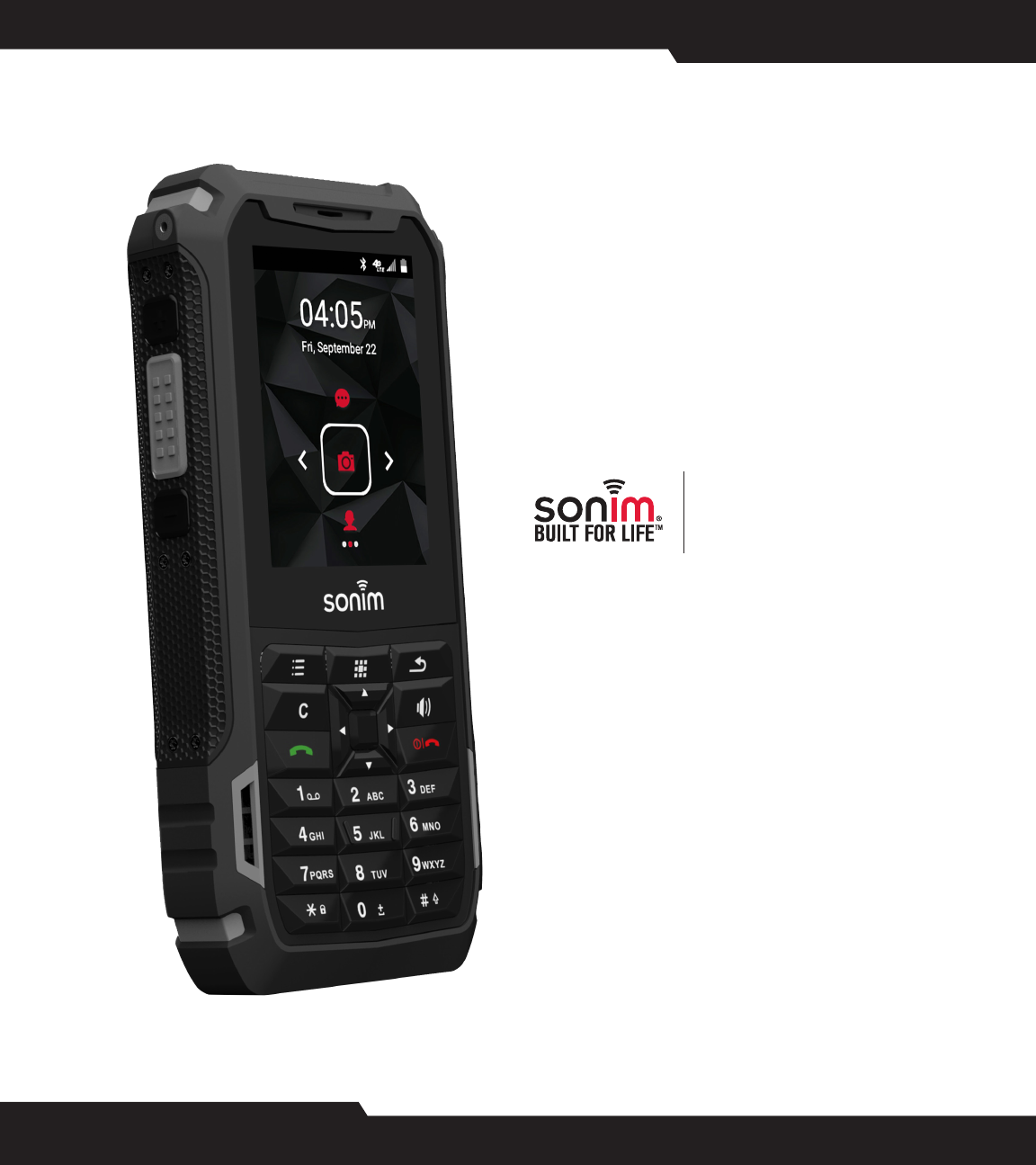
1
CONTENT
© 2017 by Sonim Technologies, Inc. All rights reserved. Version 1 11.07.2017
XP5s
USER GUIDE
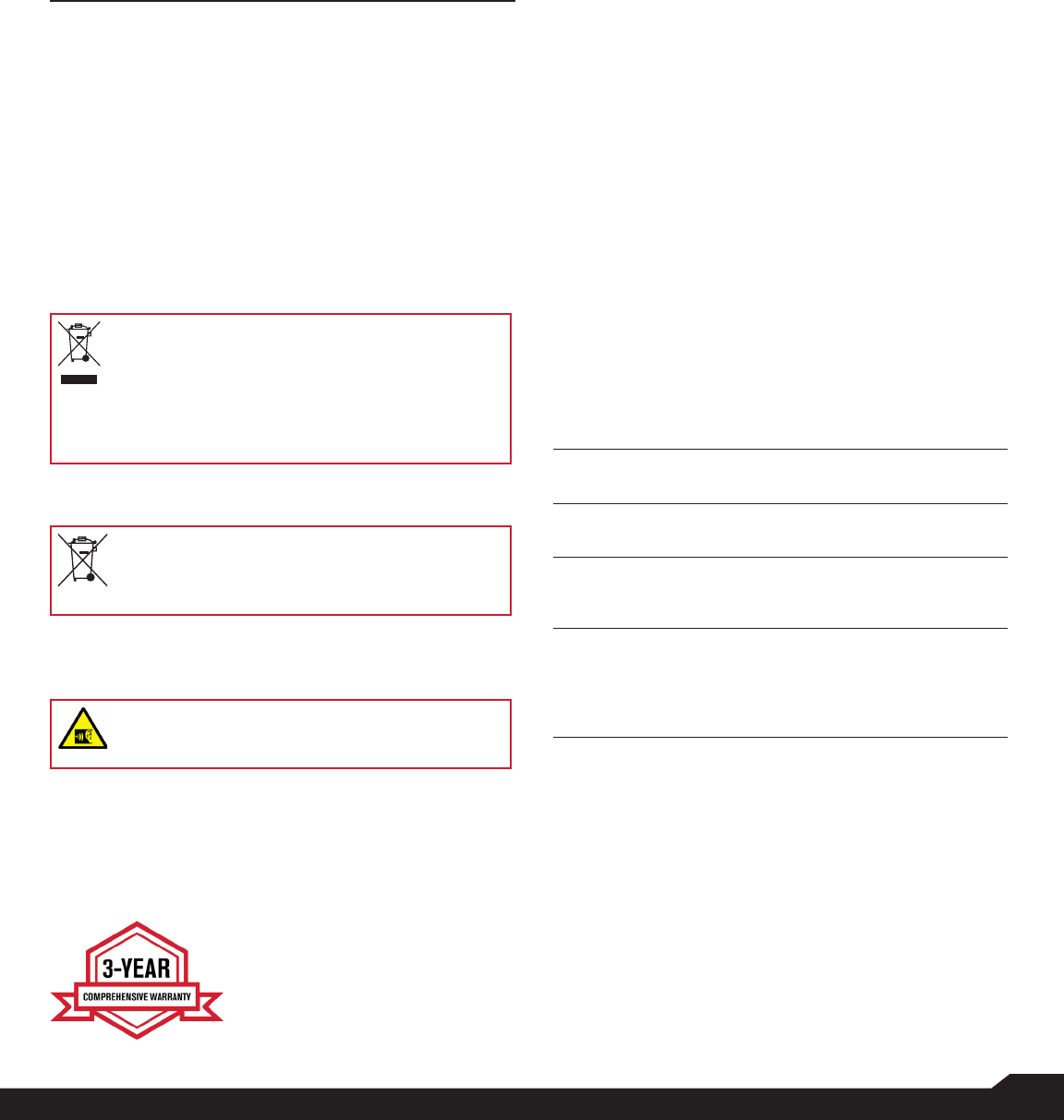
2
GENERAL INFORMATION
GENERAL INFORMATION
Copyright © 2017 Sonim Technologies, Inc.
Sonim and the Sonim logo are trademarks of Sonim
Technologies, Inc. Other company and product names
may be trademarks or registered trade-marks of the
respective owners with whom they are associated.
THIRD PARTY TRADEMARKS
Google, Android, Google Calendar, Google Now, Google
Play and other marks are trademarks of Google Inc.
DISPOSAL OF OLD ELECTRICAL AND
ELECTRONIC EQUIPMENT
The symbol of the crossed-out wheeled
bin indicates that within the countries in
the European Union, this product, and any
enhancements marked with this symbol,
cannot be disposed as unsorted waste but
must be taken to separate collection at their
end- of-life.
DISPOSAL OF BATTERY
Please check local regulations for disposal of
batteries. The battery should never be placed
in municipal waste. Use a battery disposal
facility if available.
GUIDELINE FOR HEADPHONE AND
EARPHONE
To prevent possible hearing damage, please
do not listen at high volume levels for long
periods.
REGISTER YOUR PHONE
Please register your phone at
www.sonimtech.com/register, to receive product
information and updates.
Sonim devices are covered by a
3-Year comprehensive warranty.
The embedded battery is covered
by a 1-Year limited warranty.
Congratulations on the purchase of a Sonim
XP5800
mobile phone! This phone is an LTE smartphone
enabled and has an intuitive feature-rich user
interface, which allows you to make the best use of
offered functions.
PHONE MODELS COVERED
This user guide covers Sonim XP5s phone with the
model number
XP5800
. The model name can be seen
on backside of the phone.
SONIM SUPPORT INFORMATION
For additional product and support information, visit
www.sonimtech.com.
OPTIONS COMMONLY USED ACROSS
MENU ITEMS
The following are common actions used across
various menu items:
OK
Conrms an action. Use the
Center
selection key to perform this function.
BACK
Use this key to display the previous
screen.
MENU
Moves the current working application to
the recent applications list/background
and displays menu screen.
RECENT
Displays the thumbnails of the
applications that you have worked on
recently. To remove any application from
this list, Select Remove from list from
option.

3
TABLE OF CONTENTS
GENERAL INFORMATION 2
THIRD PARTY TRADEMARKS ................................. 2
DISPOSAL OF BATTERY ............................................ 2
GUIDELINE FOR HEADPHONE AND
EARPHONE ......................................................................2
REGISTER YOUR PHONE ........................................... 2
PHONE MODELS COVERED ......................................2
SONIM SUPPORT INFORMATION .......................2
OPTIONS COMMONLY USED ACROSS MENU
ITEMS .................................................................................2
SAFETY GUIDELINES 5
AVOID HIGH TEMPERATURES ...............................6
PERSONAL MEDICAL DEVICES ..............................6
CHILD SAFETY ............................................................... 6
EMERGENCY CALLS ....................................................6
BATTERY USAGE ............................................... ...6
INSERTING THE BATTERY ....................................... 6
CHARGING THE BATTERY .......................................7
YOUR SIM CARD ...........................................................7
REMOVING THE BATTERY .......................................8
INSERTING MEMORY CARD ....................................8
DISPOSAL OF BATTERY ............................................ 9
WARNING .........................................................................9
VERIFYING AND OPTIMIZING BATTERY
USAGE................................................................................9
TIPS TO EXTEND THE BATTERY LIFE ................9
GETTING STARTED 9
WHAT IS IN THE BOX ? ..............................................9
USING YOUR SONIM XP5s 11
SWITCHING ON THE PHONE ................................. 12
SETTING UP YOUR PHONE ....................................12
MANAGING HOME SCREEN ................................... 12
NOTIFICATION BAR ICONS ...................................13
PHONE OPERATIONS WITHOUT SIM CARD ..13
SETTING UP AND USING LOCK SCREEN ........ 13
CHANGING THE WALLPAPER ............................. 14
TAKING A SCREENSHOT ....................................... 14
TEXT ENTRY OPTIONS ........................................... 14
TO ENTER A WORD ................................................... 14
TO INSERT A NUMBER: .......................................... 14
MANAGING WIRELESS & NETWORK
SETTINGS 15
WI-FI NETWORK ......................................................... 15
BLUETOOTH DEVICES ............................................. 15
SIM CARDS ................................................................... 16
DATA USAGE ............................................................... 16
MORE ............................................................................... 16
ACTIVATING AIRPLANE MODE .................................... 16
CELLULAR NETWORKS ................................................... 16
NETWORK SETTINGS RESET ......................................... 16
VOICE NOISE CANCELLATION....................................... 16
MANAGING DEVICE SETTINGS 17
DISPLAY ........................................................................ 17
PROFILES ...................................................................... 17
GESTURES .................................................................... 19
MANAGING PERSONAL SETTINGS
20
EMERGENCY INFO .................................................... 20
LOCATION ACCESS .................................................. 20
SECURITY ...................................................................... 20
LOCKING YOUR SIM CARD .................................... 20
MANAGING CREDENTIAL CERTIFICATES ..... 21
ENCHANCED LOCATION SETTINGS ................. 21
APPS ACCESSING YOUR LOCATION ............... 21
LANGUAGE & INPUT ................................................ 21
FACTORY RESET ....................................................... 21
MANAGING SYSTEM SETTINGS 22
TABLE OF CONTENTS

4
TABLE OF CONTENTS
DATE & TIME 22
MANAGING CONTACTS 23
ADDING A NEW CONTACT ................................. 23
VIEWING CONTACT DETAILS ............................ 23
SENDING A MESSAGE FROM CONTACTS ... 23
DIALING A NUMBER FROM CONTACTS ....... 23
EDITING THE CONTACT DETAILS ................... 23
IMPORTING SIM CARD CONTACTS TO
PHONE .......................................................................... 23
EXPORTING PHONE CONTACTS TO SIM
CARD ............................................................................. 23
EXPORTING PHONE CONTACTS TO
STORAGE .................................................................... 24
SHARING CONTACT VIA MMS AND
BLUETOOTH ............................................................... 24
MANAGING CONTACT SETTINGS ................... 24
MANAGING PHONEBOOK SETTINGS ............ 24
DELETING A CONTACT ......................................... 24
MANAGING CALL SETTINGS 25
MAKING A CALL ....................................................... 25
DIALING A NUMBER VIA CONTACT ............... 25
ADDING A CONTACT FROM HOME SCREEN
.......................................................................................... 25
VIEWING CALL HISTORY ..................................... 25
DELETING CALL HISTORY ................................... 25
MANAGING CALL SETTINGS ............................. 25
CHANGING RINGTONES AND MASTER
VOLUMES .................................................................... 26
SPEED DIAL SETTINGS ......................................... 26
SENDING MESSAGES 27
SENDING SMS/MMS MESSAGE ...................... 27
MANAGING MESSAGE SETTINGS ................... 27
USING THE KEYBOARD 29
ENTER AND EDIT TEXT ......................................... 29
PHONE DICTIONARIES ......................................... 29
PERSONAL DICTIONARY ..................................... 29
PSX PTT SERVICES 29
LAUNCHING PSX PTT APPLICATION .................... 29
<EXTERNAL LINK - MSI WEBSITE> ......................... 29
SONIM SETUP WIZARD 30
USING APPLICATIONS 30
CAMERA .............................................................................. 30
CALENDAR ........................................................................ 30
CLOCK ................................................................................... 31
ALARM .................................................................................... 31
STOPWATCH .......................................................................... 31
TIMER ...................................................................................... 31
CALCULATOR .................................................................... 31
SOUND RECORDER ......................................................... 31
MUSIC ................................................................................... 31
FILE EXPLORER ................................................................ 32
REGULATORY INFORMATION-
EUROPEAN MARKET 32
EU REGULATORY CONFORMANCE ......................... 32
FREQUENCY BANDS ...................................................... 32
5G WI-FI .............................................................................. 33
LVD LOGO............................................................................ 33
DIPOSAL OF OLD ELECTRICAL AND
ELECTRONIC EQUIPMENT LOGO ............................. 33
ADAPTER ............................................................................. 33
REGULATORY INFORMATION - USA
MARKET 33
RF EXPOSURE INFORMATION (SAR) ..................... 33
FEDERAL COMMUNICATION COMMISSION
INTERFERENCE STATEMENT .................................... 34
FCC CAUTION ................................................................... 34
ISED RF EXPOSURE STATEMENT (IC) ................... 34
HAC RATING ...................................................................... 34
HAZARDOUS LOCATION USAGE
WARNING 36
INDEX 37
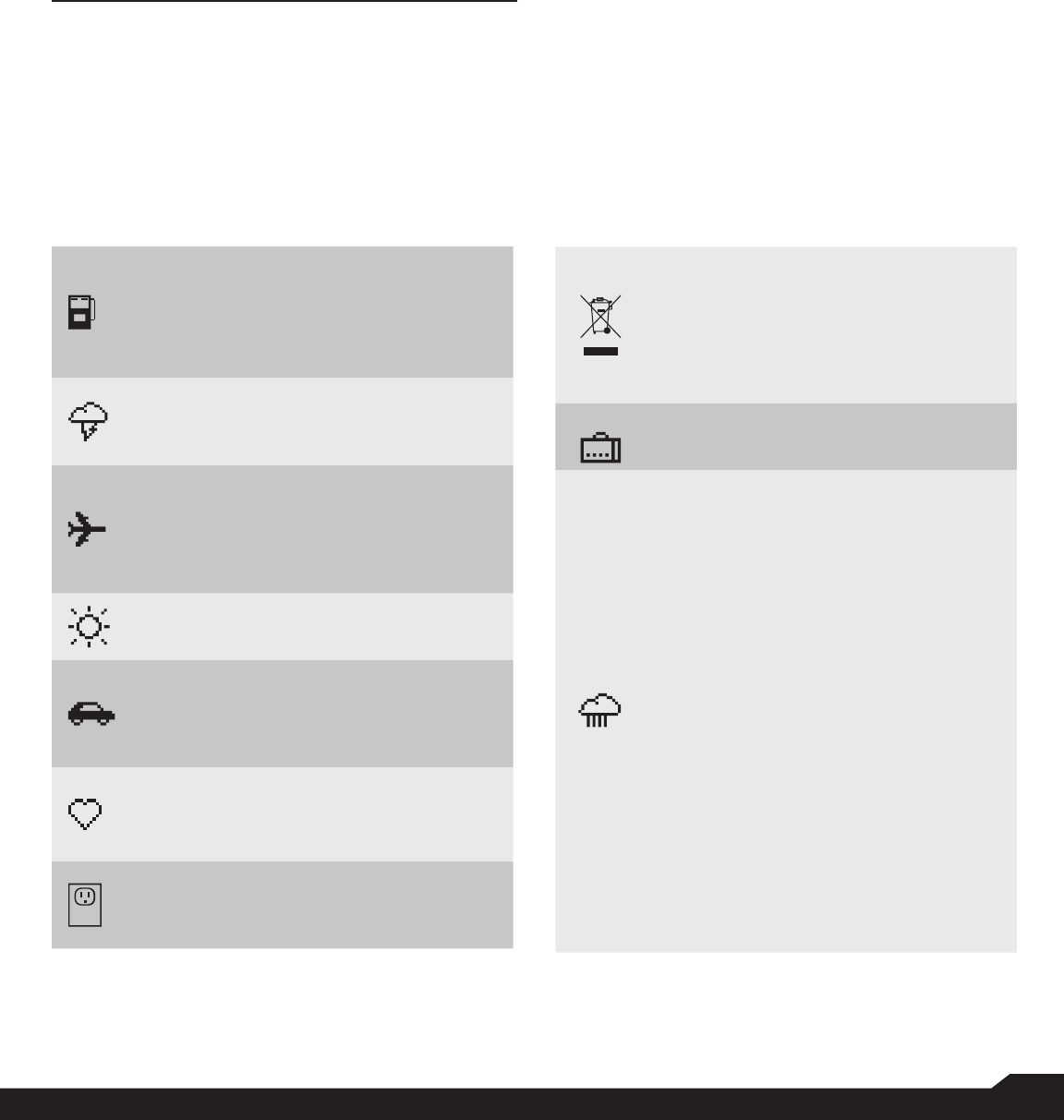
5
SAFETY GUIDELINES
SAFETY GUIDELINES
Please read and understand the following
safety guidelines before you use the
phone. These guidelines provide details to
enable you to operate your phone safely
and conform to any legal requirements
regarding the use of cellular phones.
Do not to use the phone at a refueling
point. Observe restrictions when using
radio equipment at fuel depots, chemical
plants or where blasting operations are in
progress.
Electrical interference may obstruct the
use of your phone. Observe restrictions in
hospitals and near medical equipment.
Switch off your cellular phone when in
an aircraft. Wireless phones can cause
interference or danger to an aircraft. In an
aircraft, the phone can be used in ight
mode.
Do not expose the device to high
temperatures (in excess of 55°C).
Adhere to road safety laws. Do not hold/
use a phone while you are driving; nd a
safe place to stop rst. Use hands-free
microphone while you are driving.
Avoid using the phone in close proximity
to personal medical devices, such as
pacemakers and hearing aids.
Use only Sonim XP5800 approved
charging equipment to charge your phone
and avoid damage to your phone.
The symbol of the crossed-out wheeled
bin indicates that this product, and any
enhancements marked with this symbol,
cannot be disposed as unsorted waste but
must be taken to separate collection at
their end-of-life.
Ensure that only qualied personnel install
or repair your phone.
The Sonim XP5800 is water-proof and can
be submerged to 2 meters for 30 minutes.
Ensure to close the audio connector
and SIM slot properly. This will prevent
the deposit of water droplets on the
connectors, when the phone is immersed
in water.
Water droplets may condense under the
display cover if the phone is immersed in
water with signicant drop in temperature.
This does not indicate water leakage.
The droplets will disappear at room
temperature.
The Sonim XP5800 is dust-resistant,
rugged and shock-resistant. However, it is
not dust-proof or unbreakable if subjected
to overwhelming impact. For best results
and long product life, one should protect
the Sonim XP5800 from salt water, dust
and strong impacts.
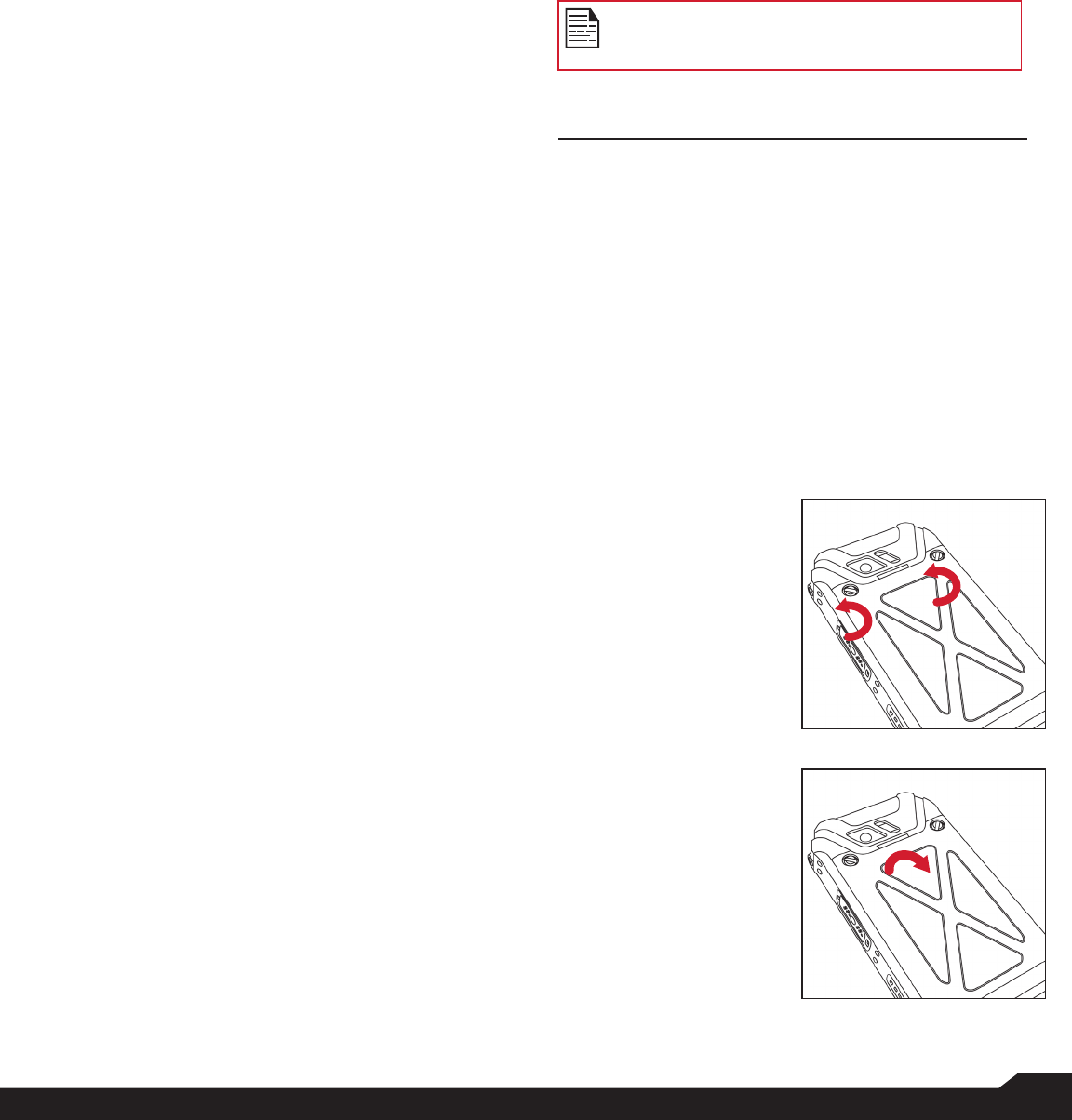
6
SAFETY GUIDELINES / BATTERY USAGE
AVOID HIGH TEMPERATURES
Leaving the device in hot or cold places, such as in a
closed car in summer or winter conditions, reduces the
capacity and lifetime of the battery. For the best results,
try to use the device between -20°C and +55°C (-4°F
and 131°F). A device with a hot or cold battery may
not work temporarily, even when the battery is fully
charged. Battery performance is particularly limited in
temperatures well below freezing.
PERSONAL MEDICAL DEVICES
Mobile phones may affect the operation of cardiac
pacemakers and other implanted equipment. Please
avoid placing the mobile phone over the pacemaker, for
example in your breast pocket. When using the mobile
phone, place it at the ear opposite the pacemaker. If a
minimum distance of 15 cm (6 inches) is kept between
the mobile phone and the pacemaker, the risk of
interference is limited. If you suspect that interference
is taking place, immediately turn off your mobile phone.
Contact your cardiologist for more information. For
other medical devices, consult your physician and the
manufacturer of the device. Comply with instructions to
switch off the device or deactivate the RF transmitter
when required, especially when posted in hospitals
and airplanes. Equipment used in these places may be
sensitive to radio waves emitted from the device and
adversely affect their operation. Also, observe restrictions
at gas stations or other areas with ammable atmosphere
or when close to electro-explosive devices.
CHILD SAFETY
Do not allow children to play with your mobile phone or
its accessories. Keep it out of their reach. They could hurt
themselves or others, or could accidentally damage the
mobile phone or accessories. Your mobile phone and
its accessories may contain small parts, which could be
detached and create a choking hazard.
EMERGENCY CALLS
Mobile phones operate using radio signals, which cannot
guarantee connection under all conditions. Therefore
you should never rely solely upon any mobile phone for
essential communications (e.g. medical emergencies).
Emergency calls may not be possible in all areas, on all
cellular networks, or when certain network services and/
or mobile phone features are in use. Check with your
local service provider.
WARNING
It is not allowed to connect any external
devices to all ports/interface (USB, XPand and
SecureAudio Connector) in Hazardous area.
BATTERY USAGE
Sonim XP5s phone comes with a removable
battery. For any battery related queries,
contact Sonim customer support.
• Use only a Sonim XP5800 certied battery that is
designed for this phone model.
• The use of other batteries may void the warranty terms
of your phone and cause damage.
• It is recommended to protect the battery from extreme
temperature environments and moisture.
• Please keep the battery out of the reach of children.
INSERTING THE BATTERY
1. UNSCREW COVER
To open the battery
cover, rotate both
the battery cover
screws in a counter
clockwise direction
(as shown in the
gure). Sometimes,
the battery cover may
be tight and some
extra effort is required
to open it. You can
use the screwdriver
provided to open the
screws.
2. LIFT THE COVER
Lift the back cover to
reveal the battery slot.
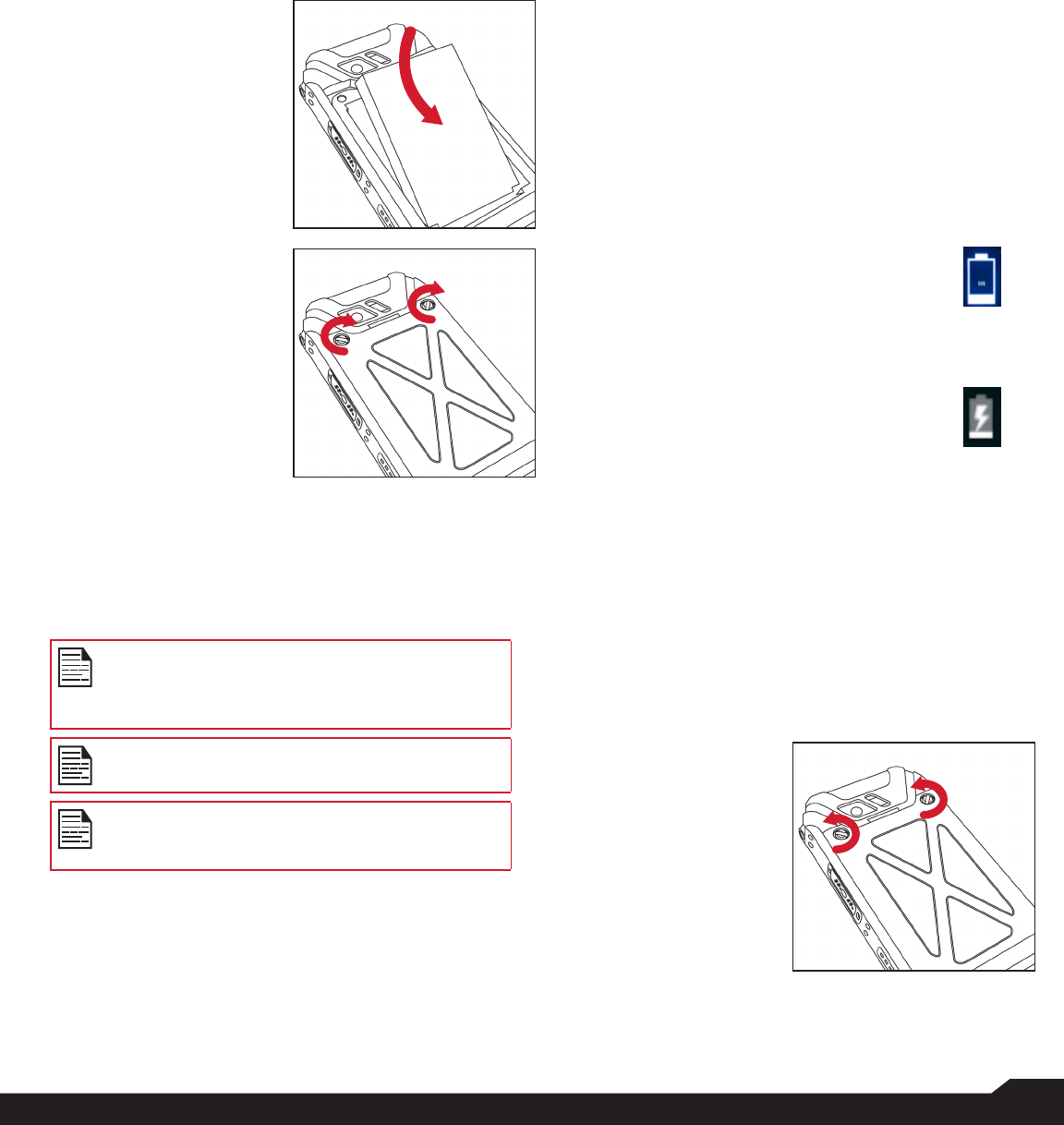
7
BATTERY USAGE
3. INSERT BATTERY
Insert the battery
and ush into the
battery slot such that
the three metallic
contacts at the top of
the battery are aligned
with the metallic
contacts within the
battery compartment.
4. CLOSE COVER
Close the battery
cover. Rotate the
battery cover screws
in clockwise direction.
You can use the
screwdriver provided
to tighten the screws.
Ensure not to over-
tighten the screws.
CHARGING THE BATTERY
The battery delivered with your mobile phone is not fully
charged. We recommend that you charge your mobile
for 5 hours before you use your mobile phone for the rst
time.
Only the power supplies with outputs meet the
SELV requirements can be used for charging.
The maximum allowable input voltage for the
phone is 9v.
There is a risk of explosion while charging if the
battery has been replaced by an incorrect type.
If the battery is completely out of charge, it can
take several minutes for the charging icon to
appear when the charger is connected.
1. INSERT CHARGER
Insert the charger plug into a power outlet.
2. CONNECT TO THE PHONE
The charging port is located in the lower side
of the phone, below the back cover. Insert the
charger connector to the charging port.
3. CHARGING ANIMATION/ICON
• If the battery is being charged when the
phone is switched off, a battery charging
animation with current battery level is
displayed.
• If the battery is being charged while the
phone is switched on, the battery icon
on the status bar shows the animation
indicating that the battery is being
charged.
• After the battery is fully charged the
charging animation stops and you can
disconnect the charger from the phone.
YOUR SIM CARD
Purchase a SIM card from a mobile operator. The SIM
card associates your network services (for example,
phone number, data services, and so on) with your
phone.
REMOVING THE BACK COVER
1. UNSCREW COVER
To open the battery
cover, rotate both the
battery cover screws
in counter clockwise
direction (as shown in
the gure).
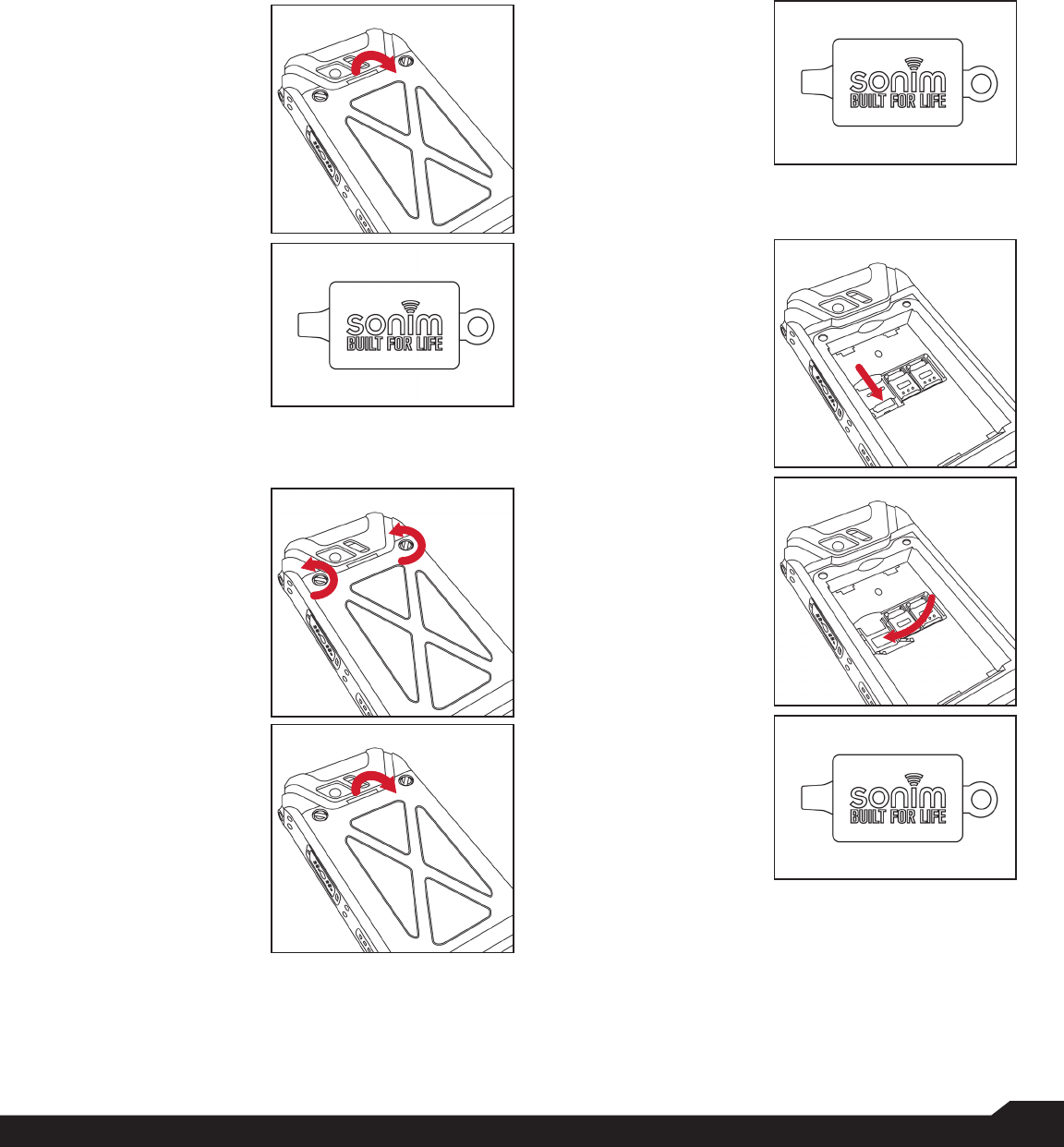
8
BATTERY USAGE
2. LIFT THE COVER
Lift the back cover to
reveal the battery slot.
3. USE SONIM
SCREWDRIVER
You can use the
Sonim provided
screwdriver tool to
open the screws.
REMOVING THE BATTERY
1. UNSCREW COVER
To open the battery
cover, rotate both
the battery cover
screws in an counter
clockwise direction (as
shown in the gure).
2. LIFT THE COVER
Lift the back cover to
reveal the battery slot.
3. USE SONIM
SCREWDRIVER
You can use the
Sonim provided
screwdriver tool to
open the screws.
INSERTING MEMORY CARD
1. SLIDE THE SILVER CLIP
Slide (push forward)
and lift the silver clip
over the designated
slot located below
the SIM card slot. (as
shown in the gure).
2. PLACE THE
MEMORY CARD
Place the memory
card in the designated
slot and close the
silver cup. (as shown
in the gure).
3. USE SONIM
SCREWDRIVER
You can use the
Sonim provided
screwdriver tool to
open the screws.
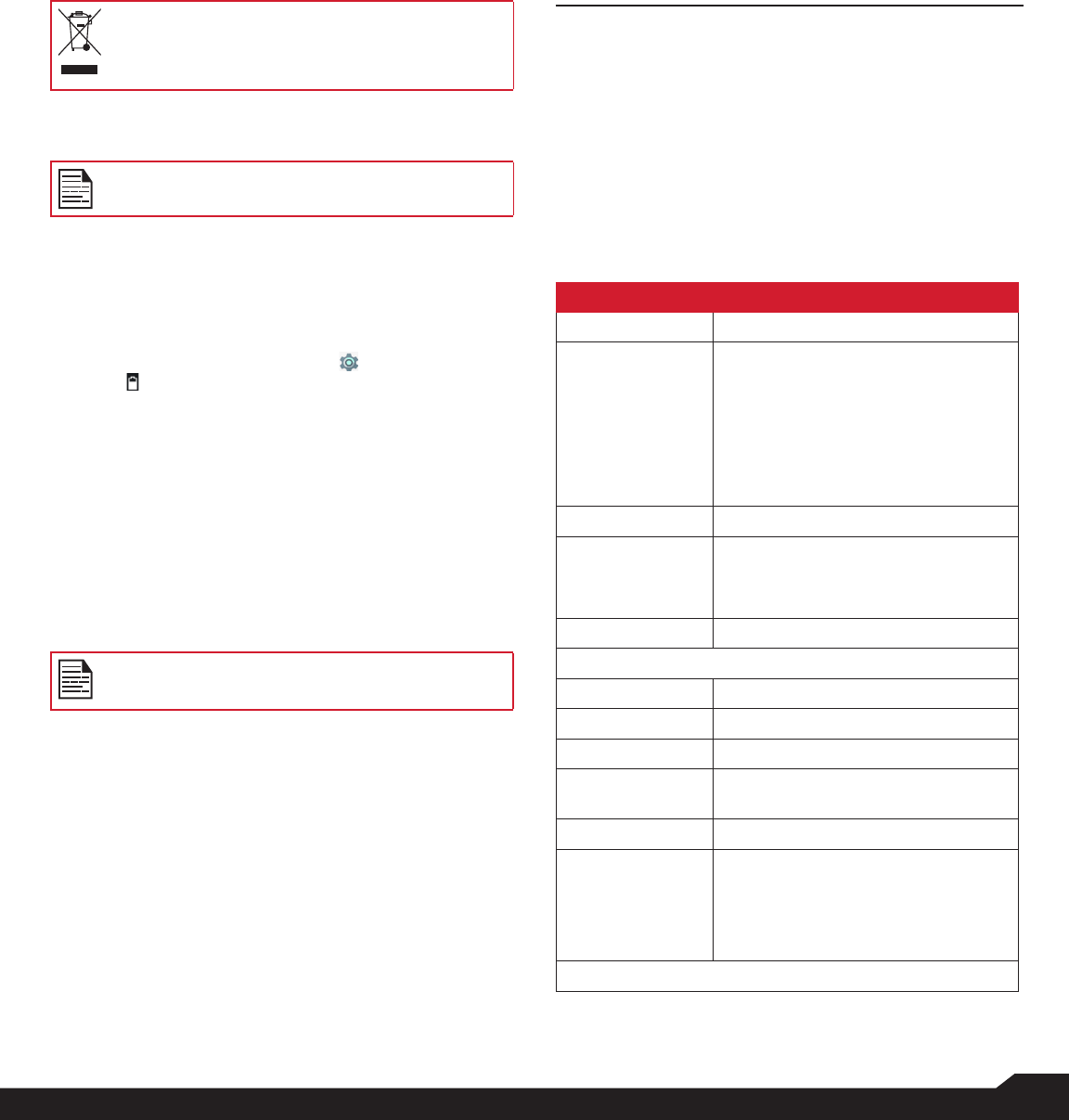
9
BATTERY USAGE / GETTING STARTED
DISPOSAL OF BATTERY
Please check local regulations for disposal of
batteries. The battery should never be placed in
municipal waste. Use a battery disposal facility if
available.
WARNING
ONLY THE BATTERY CAN BE REPLACED in
NON-HAZARDOUS LOCATION.
VERIFYING AND OPTIMIZING BATTERY
USAGE
You can check the battery usage status and also close
some applications to save battery power. In the all
application screen, select Settings ( ) > Device >
Battery ( ).
The current battery level (charging or not charging) is
displayed on the top of the screen. The discharge graph
on the top of the screen shows the battery level over time
since you last charged the device, and how long you
have been running on battery power.
The list at the bottom of the screen shows the breakdown
of battery usage for individual apps and services. Touch
any listed items for more details. The details screen for
some apps includes buttons that allow you to adjust
settings affecting power usage, or stop the application
completely.
If you stop some apps or services, your device
may not work correctly.
TIPS TO EXTEND THE BATTERY LIFE
Follow these tips to extend your phone’s battery life.
• If you are not using Wi-Fi, Bluetooth, or GPS, use
the Settings to turn them off. The GPS setting is
located in Settings > Personal > Location.
• Set screen brightness to Low and set a shorter
Sleep timeout (15 seconds). The display settings are
located in Settings > Device > Display.
• If you are travelling and do not have access to
mobile data or Wi-Fi network, switch to Airplane
mode. Select Airplane mode from Quick Settings.
GETTING STARTED
WHAT IS IN THE BOX ?
The list of items in the Sonim XP5s phone box are:
• Sonim XP5s
• Battery
• Wall Charger
• USB-C Cable
• Screwdriver
• Quick Start Guide
PHONE SPECIFICATIONS
FEATURE DESCRIPTION
Chipset Qualcomm MSM8920
Band GSM:
850/900/1800/1900MHz
UMTS:
I/II/IV/V/VIII
CDMA:
BC0/BC1/BC10
LTE:
B1/B2/B3/B4/B5/B7/B8/B12/
B13/B14/B25/B26/B28/B30/B38/
B41/B66
Antenna MIMO antenna for LTE
Wi-Fi Support 802.11 a/b/g/n/ac/e/k/r/h
Support max 10 connections
hotspot
Memory 16GB eMMC + 2GB DDR
CONNECTIVITY
Bluetooth BT4.x with BLE
SMS/MMS BLESupport SMS and MMS
GPS GPS/aGPS, GLONASS, BDS
Languages
Supported English and Spanish
Capacity(mAh) 3180mAh, removable Li-ion
Battery Life Standby: up to 267 hours
Talk time: up to 19 hours
Music playback: up to 59 hours
Video playback: up to 8.5 hours
Web browsing: up to 7.5 hours
PHYSICAL CHARACTERISTICS

10
GETTING STARTED
FEATURE DESCRIPTION
Ambient
temperature -20ºC to +55ºC
Protection
Class IP-68, 2meters for 1 hour
Size 141mm x 63.9 mm x 23mm
Weight approx. 248 gms
Dedicated keys PTT Key/Alarm Key/Power Key
Ports Water-proof USB2.0 type-C, High
Speed, OTG
DISPLAY
Size 2.64”
Resolution 432x320 Transmissive, 350 nits
Brightness
Outdoor
Visibility Yes
Capacity 262 K colors
AUDIO
Microphone 3 Mics with noise cancellation
Speaker Front Dual Loud Speaker, Support
HD voice and wideband
MULTIMEDIA
Audio Formats AMR-NB, AMR-WB, AAC, AAC+,
AAC+V2, MP3,V-SELP, AMR
12.65, AMR 6.6, WAV
Video Formats 3GP,MP4, WMV, AVI, MOV,
MPEG-2, MPEG-4,H.263, H.264
FM Radio Yes
Camera 5MP FF Rear camera, No front
camera
LED Torch Light Yes, also used for camera ash
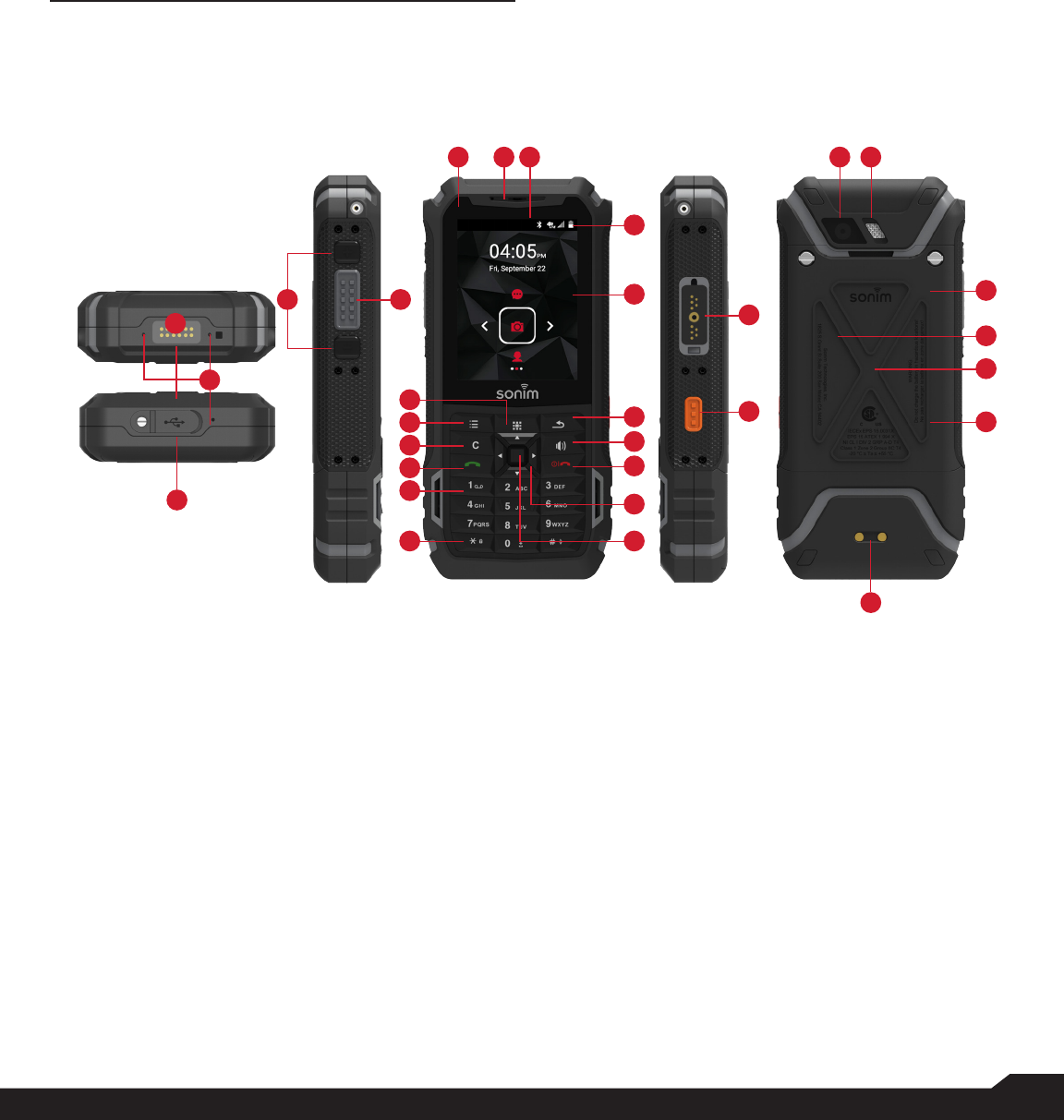
11
USING YOUR SONIM XP5s
USING YOUR SONIM XP5s
1. Sonim XPand Connector
2. Microphones
3. USB-C
4. Volume Up / Down
5. PTT Button
6. App Tray
7. Options
8. Clear
9. Answer / Accept
10. Voicemail (Press and Hold)
11. Lock Keypad (Press and Hold)
12. Select /Center key
13. Navigation
14. End / Reject / Power On & Off (Press and Hold)
15. Speakerphone
30
20 1921 29
28
25
22
23
54
14
13
12
15
16
17
18
6
10
9
8
7
11
27
26
24
1
2
3
16. Back
17. Display
18. Battery Level Indicator
19. Notication Bar
20. Receiver
21. LED Notication
22. Sonim SecureAudio Connector
23. Emergency Button
24. Charging Pins
25. Battery Under Door
26. SIM Card Slots Under Battery
27. Memory Card Slot Under Battery
28. Battery Door
29. Rear Flash
30. Rear Facing Camera
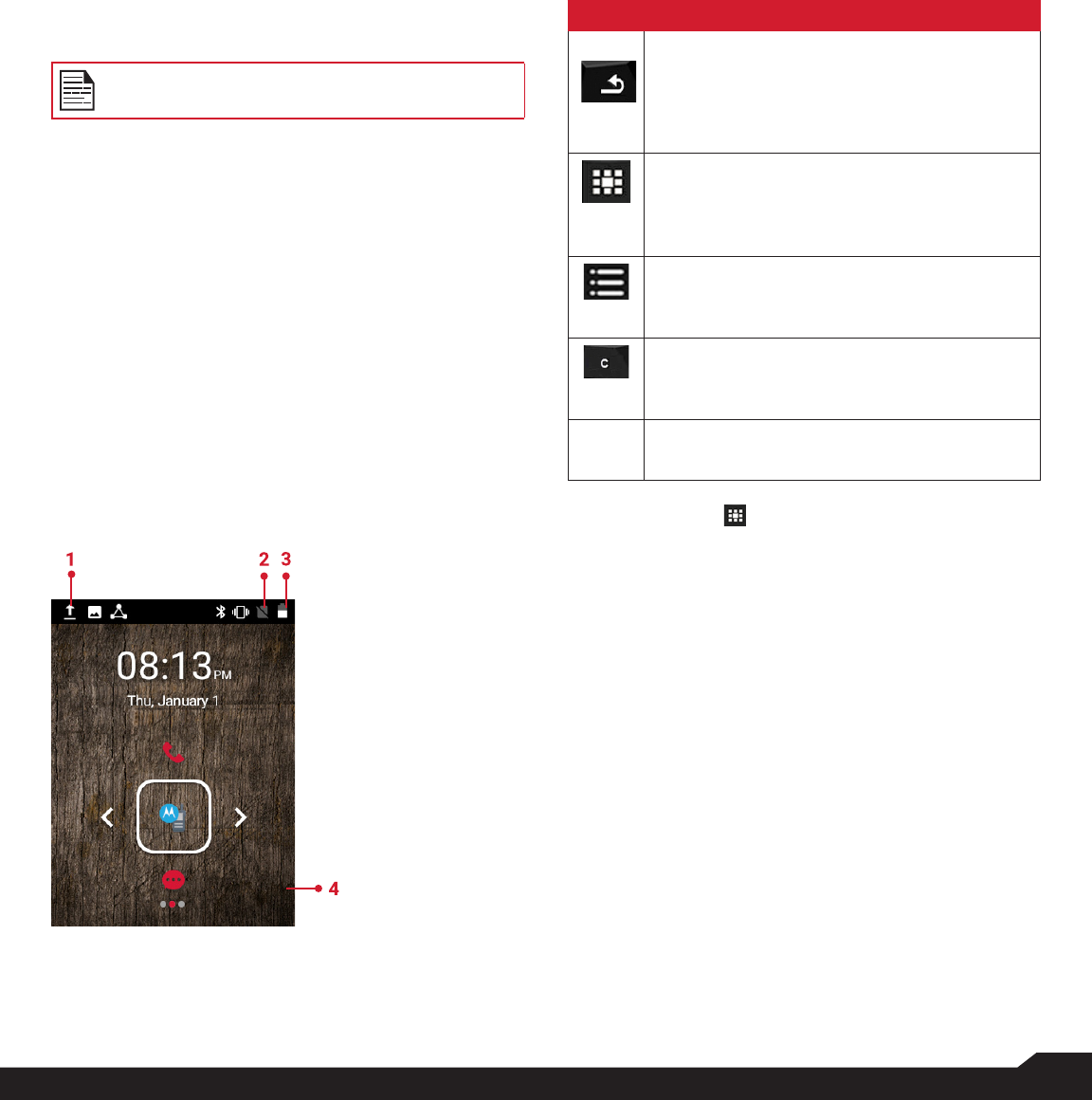
12
USING YOUR SONIM XP5s
SWITCHING ON THE PHONE
Press and hold ON/OFF Red button for 2 seconds.
When the phone is switched on, it tries to register with
the network. After successful registration, the name of the
service provider is displayed.
Ensure that a valid SIM card is inserted in your
phone.
SETTING UP YOUR PHONE
For instructions on using your phone’s buttons, charger,
battery, and other hardware features, check the printed
Quick Start Guide provided along with your phone.
When you power ON the phone for the rst time, a
Welcome screen is displayed.
To set up your phone, select Start and follow the
instructions as shown on the screen.
Press OK on welcome guide to use the phone.
MANAGING HOME SCREEN
After you complete the phone setup, the home screen
is displayed. The home screen is the beginning point to
access all the device’s features.
1. Message/Alert
Notications
2. Service
Indicator
and Signal
Strength bar
3. Battery
charge
indicator
and time
4. Home
screen
KEY DESCRIPTION
The navigation keys are located below the display screen.
KEYS DESCRIPTION
Back:
Opens the previous screens in the working
sequence till the home screen is displayed.
Once the home screen is displayed, it remains
there even when you press the back key.
Menu:
Moves the current working application to
the recent applications list/background and
displays menu screen.
Options:
displays the options for the currently active
screen.
Clear:
Clears the entered text and deletes the
selected le.
Torch:
Enables the ashlight.
The Menu option ( ) is always positioned in the center
of the favorites tray. Select it to view all the applications.
The Notications on the top of the display screen
provides details about various notications such as
missed calls, new messages and missed alarms.
The System Icons on the right display the current device
status such as wireless and network connection strength,
battery level and time.
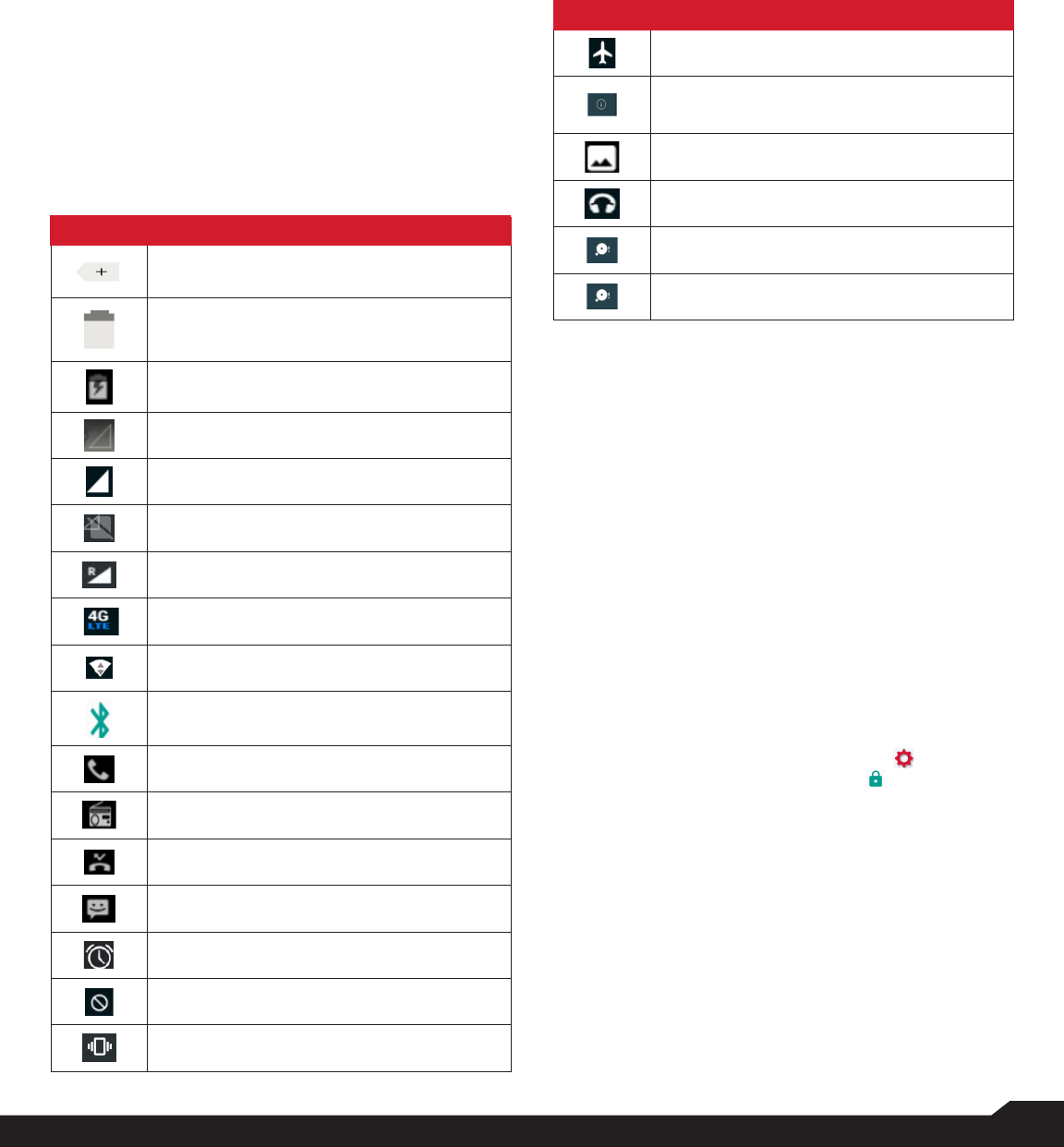
13
USING YOUR SONIM XP5s
NOTIFICATION BAR ICONS
The icons displayed at the top of the screen provides
information about the status of the device. The details
such as date and time, battery charge status, and data
service are displayed when the phone is in standby
mode. Other indicators such as Bluetooth connectivity
status, airplane mode, alarm and call forward (only if
Always forward is enabled) and Wi-Fi connectivity are
displayed, if the feature is activated.
ICONS DESCRIPTION
Notication icon
Battery level indicator
Battery charging in progress
No signal
Signal strength
No SIM card
Roaming
4G LTE network connected
Wi-Fi connected
Bluetooth activated
Call in progress
FM Radio
Missed call
New SMS or MMS
Alarm activated
Silent mode activated
Vibration mode activated
ICONS DESCRIPTION
Flight mode activated
Error/information notication - attention
required
Screenshot captured
Music is played
Device storage space is running out
Stealth Prole
PHONE OPERATIONS WITHOUT SIM CARD
You can perform the following operations without
inserting a SIM card in your phone.
• Make an emergency call.
• View and modify all settings except few data usage
and mobile network related settings.
• Activate and share les through Bluetooth.
• Access the Internet using Wi-Fi conectivity.
• Access your phonebook, myles multimedia les,all
tools and applications.
• View and modify your prole settings.
SETTING UP AND USING LOCK SCREEN
You must lock your phone to protect it from unauthorized
access.
• From Home screen, select Options key > System
settings or select Menu > Settings ( ).
• Scroll down and select Security ( ) , located
under Personal settings.
• Select Screen lock and select one of the following
options to congure phone:
• None
• Press and hold * key.
• PIN: When enabled, enter you own PIN value.
When the phone is locked, unlock it using the PIN.
When the phone screen is locked, you can answer an
incoming call, without unlocking the screen.

14
USING YOUR SONIM XP5s
CHANGING THE WALLPAPER
You can set an image or a photo stored in your phone as
your home screen wallpaper. To change the wallpaper,
select from one of the following Wallpaper collections.
• From Home screen, press Options key >
Wallpaper. Select wallpaper from the popup.
• Gallery: includes photos and screenshots taken
using the phone’s camera.
• Wallpapers: includes images that are pre-loaded
with the phone.
TAKING A SCREENSHOT
You can take the screenshot of the current screen and it
is stored in your phone’s gallery. To take a screenshot:
1. Ensure that the image to be captured is displayed on
the current screen.
2. Press the Power and Volume down button
simutaneously. The screenshot is captured and
stored in the gallery. A screen Capture ( )
icon is also displayed on the notication bar.
TEXT ENTRY OPTIONS
When you enter the text message, you can change the
text entry options by pressing the # key. The current text
entry options are displayed in the top bar.
The various text entry options are:
• ABC: Enter all the text in upper case.
• Abc: Enter the rst letter of the sentence in upper
case.
• abc: Enter all the text in lower case.
• 123: Enter the numbers.
• T9ABC: Enter the text based on the T9 dictionary.
All the letters are in upper case (capitalized).
• T9abc: Enter the text based on the T9 dictionary. All
the letters are in lower case.
• T9Abc: Enter the text based on the T9 dictionary.
Only the rst letter of the paragraph is in upper case
(capitalized).
TO ENTER A WORD
1. Start by pressing the numeric keys from 2 through 9
only once for the required letter.
• Ex 1: To enter the word Good, press 4-6-6-3. The
word displays on the screen as you type.
• Ex 2: To enter the word Hello, press 4-3-5-5-6.
The word displays on the screen as you type.
2. If the word does not display correctly, press right
navigation key to scroll through alternative word
choices. Press either the center navigation key or
0 key to accept the word.
TO INSERT A NUMBER:
1. Press the key labeled with the number you want and
use the navigation key to scroll to that number as
above.
2. To insert a symbol, press and hold the numeric
key 1 and use the navigation key to scroll and
select a symbol.
THE DIFFERENT METHODS TO ENTER TEXT:
• T9EN: Enter the text based on the T9 dictionary. All
the letters is in upper case (capitalized).
• T9En: Enter the text based on the T9 dictionary.
Only the rst letter of the paragraph is in upper case
(capitalized).
• T9en: Enter the text based on the T9 dictionary. All
the letters are in lower case.
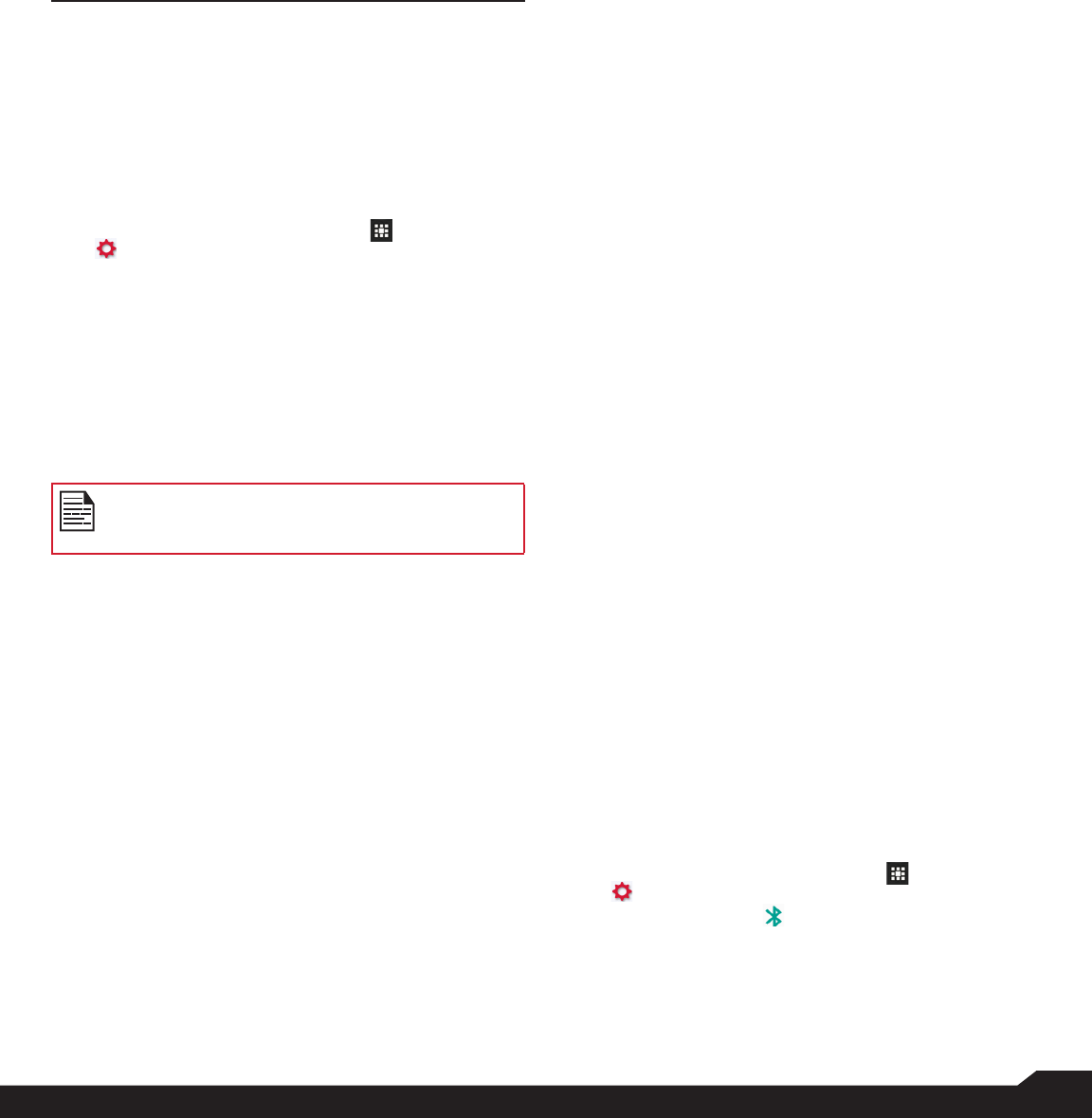
15
MANAGING WIRELESS & NETWORK SETTINGS
MANAGING WIRELESS & NETWORK
SETTINGS
WI-FI NETWORK
Wi-Fi is a wireless network technology that can provide
Internet access at distance upto 100 feet, depending on
the Wi-Fi router and surroundings.
You can access Internet when you connect your XP5s
to a Wi-Fi network. To connect your phone to a Wi-Fi
network,
1. From Home screen, select Menu ( ) > Settings
( ).
2. Set the Wi-Fi to ON position, located under
Wireless & networks settings.
3. Select Wi-Fi.
A list of Wi-Fi routers present within your phone’s
accessible range are displayed.
4. Select your preferred network. Enter the WEP/
WPS/WPA key (if it is a secured network) and
select Connect. To verify the password before
connecting, enable Show password.
It is always recommended to make your Wi-Fi
router secure and also to connect your phone to
a secure network.
ADDING A NEW NETWORK
1. In Wi-Fi settings screen, select Options key > Add
network.
2. Enter the following details:
• Network SSID: The wireless network ID.
• Security: Set the security type to None, WEP,
WPA/WPA2 PSK, 802.1x EAP.
3. Enable Advanced to set the Proxy details and IP
settings.
CONNECT TO A NETWORK
1. Press and hold the connected network.
2. Select Connet to network.
3. Enter the password and get connected to the
network.
EDITING A NETWORK
1. Press and hold the connected network.
2. Select Modify network. You cannot change the
network password. The other network setting
details such as Advanced options, Proxy, IP
settings can be updated.
3. Select Save to save the changes.
FORGETTING A NETWORK
1. Touch and hold the connected network.
2. Select Forget network.
The selected network gets disconnected and
displayed in the Wi-Fi list.
If you have to get connected to the same network,
enter password.
ADVANCED WI-FI
On the Wi-Fi screen, select Option key > Advanced. The
following options are displayed:
• Install certicates: You can select the certiaction
by browsing.
• Passpoint on: You can enable the option.
• Wi-Fi Direct: Select Option key > Searching to
search for the peer devices and also select Rename
device to rename the device.
• WPS Push Button: Press the WPS Push Button in
your router, when prompted.
• WPS Pin Entry: Enter the given PIN number on your
Wi-Fi router.
BLUETOOTH DEVICES
Bluetooth is a short-range wireless communication
technology used to communicate between the devices
over a distance of about 8 meters.
You can perform the following tasks using Bluetooth
paired devices.
• Transfer media les and contacts between
connected mobile devices using Bluetooth.
• Access the Internet through a Bluetooth device that
is connected to a Wi-Fi router.
• Use Bluetooth connected headphones for playing
media le.
PAIRING A BLUETOOTH DEVICE
To activate Bluetooth and pair your XP5s phone with
other Bluetooth devices:
1. From Home screen, select Menu ( ) > Settings
( ).
2. Enable Bluetooth ( ), located under Wireless &
Networks settings.
A list of accessible Bluetooth devices are displayed.
Ensure that Bluetooth is activated on the other device
too.
3. Select your preferred device.
4. Conrm the pass key in the other device and

16
MANAGING WIRELESS & NETWORK SETTINGS
select Pair in your phone. The device is displayed
in the Paired devices list.
EDITING PAIRED BLUETOOTH DEVICE SETTINGS
1. Press Option key on preferred paired Bluetooth
device.
2. Select Rename this device to rename the paired
Bluetooth device.
3. Select Unpair to remove the device from your
paired list.
4. Enable Media Audio to connect the Bluetooth
device for listening to media les.
5. Enable Internet access to use the paired
Bluetooth device to access the Internet.
SIM CARDS
DATA USAGE
Data usage refers to the amount of data utilized by your
phone during data transfers through the Internet. The
data usage charges are dependent of the wireless plan
provided by your service provider.
To monitor your data usage, adjust your data usage
settings.
1. From Home screen, select Menu ( ) > Settings
( ).
2. Tap on Data usage ( ), which is located under
Wireless & networks settings.
3. Turn on Cellular Data to access Internet using
your cellular network
4. Enable Set cellular data limit to preset your data
usage limit and to set an alert before reaching the
preset limit.
5. Drag the orange bar to set the Data usage limit.
Cellular data will get disabled once you reach this
limit. You will not be able to access the Internet.
You receive a notication once you reach the set
data usage limit.
6. Drag the black bar to set data usage warning so
that you will get an alert before reaching your set
data usage limit.
MORE
ACTIVATING AIRPLANE MODE
When your phone is set in airplane mode, network
connectivity or mobile data connectivity is disabled.
But you can access your camera, medial les and other
features that do not require mobile connectivity.
To activate airplane mode:
1. From Home screen, select Menu ( ) > Settings
( ).
2. Select More located under Wireless & networks
settings.
3. Enable Airplane mode.
CELLULAR NETWORKS
You can view and set your mobile service provider
settings.
Following are the options:
1. From Home screen, select Menu ( ) > Settings
( ) > More.
2. Select Cellular networks.
3. Enable Enchanced 4G LTE Mode to improve the
voice and other commnication quality.
4. Enable Data roaming to have network
connectivity when you are in a roaming network.
5. Select Cellular Network Setting under Cellular
Network.
6. Select Access Point names to view and edit the
network access points.
• Select Options > New APN to add a new access
point.
7. Choose the Network operators from the
available list.
NETWORK SETTINGS RESET
1. From Home screen, select Menu ( ) > Settings
( ).
2. Select Wireless & Networks > More > Network
settings reset.
3. Select RESET SETTINGS.
It reset all the network settings including Wi-Fi,
Cellular data , and Bluetooth.
VOICE NOISE CANCELLATION
By default, FENS is enabled and reduces the noise
cancellation.
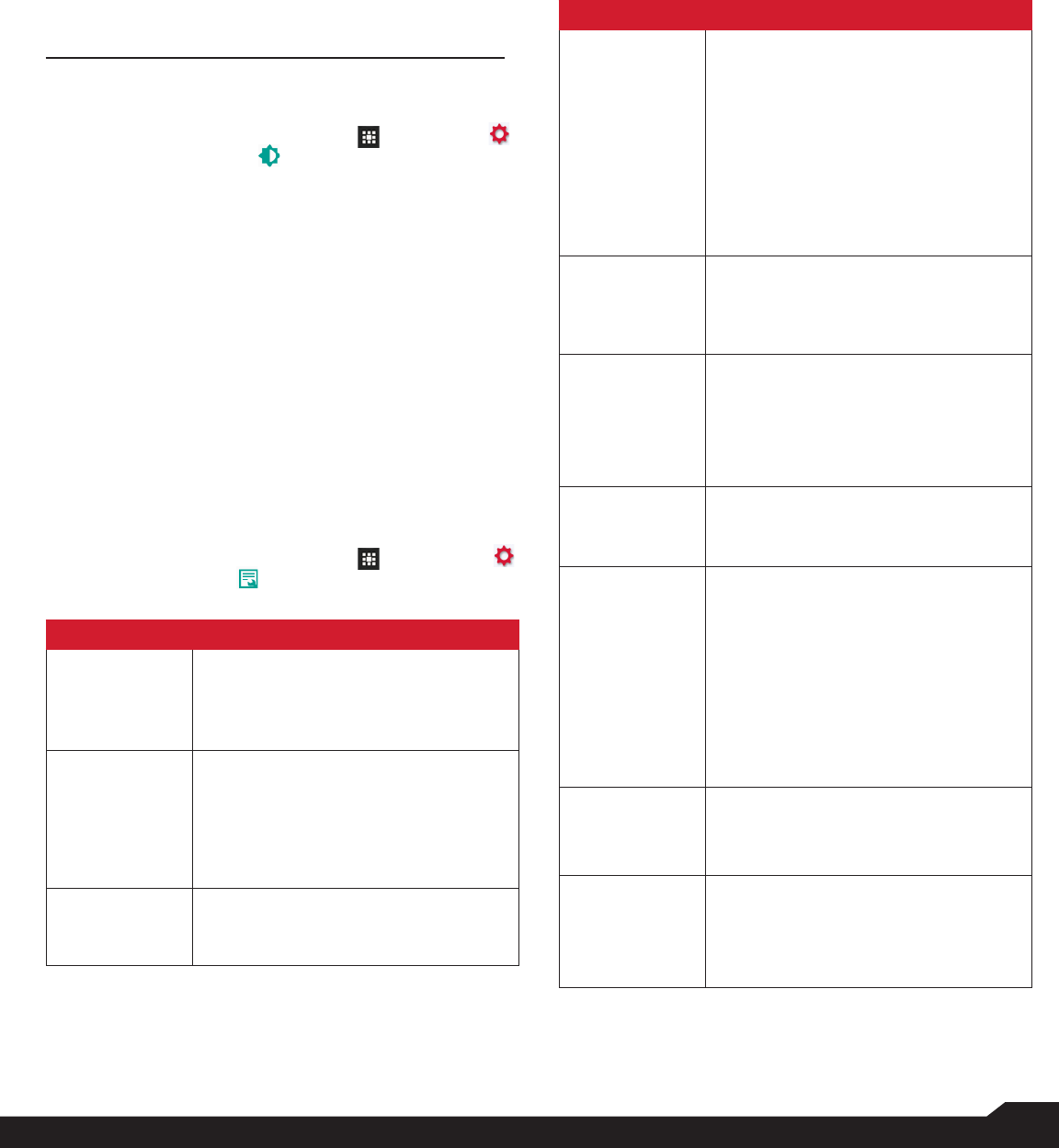
17
CONTENT
MANAGING DEVICE SETTINGS
DISPLAY
1. From Home screen, select Menu ( ) > Settings ( )
> Device > Display ( ).
2. Set one of the following options to congure your
phone’s display:
• Brightness: Set the brightness of the phone display.
This also optimizes the battery power consumed.
• Wallpaper: Set the wallpaper for your home screen.
You can select from one of the following wallpaper
collections:
• Gallery: includes photos and screenshots taken
using the phone’s camera.
• Wallpapers: includes images that are pre-loaded
with the phone.
• Sleep: Set the sleep time so that the screen brightness
is turned down after specied time of phone inactivity.
This setting also optimizes the battery power.
• Font size: Set the font size of the text displayed in the
screen.
PROFILES
1. From Home screen, select Menu ( ) > Settings ( )
> Device > Prole ( ).
2. Select any one of the options from the below list:
OPTION DESCRIPTION
1. Standard
Set to Standard and select Option
key > Edit.
The following options are displayed:
Sound
• You can set Media volume, Ring
volume, Alarm volume, Phone
ringtone, Default notication
ringtone.
• You can enable the Vibrate when
ringing.
Other Sounds
You can set Screen lock sounds,
Charging sounds, and key press
tones.
MANAGING DEVICE SETTINGS
OPTION DESCRIPTION
Notication
• If Pulse LED light is enabled,
battery status indication is not
affected.
• If Flash notication alert is
enabled, when battery is above
20% level, you can use camera
ash ligt for missed events.
• If Flash call alert is enabled, you
can use Flash cameralight for
incoming voice call.
2. Outdoor
Set to Outdoor and select Option key
> Edit.
The following options are displed:
Sound
• You can set Media volume, Ring
volume, Alarm volume, Phone
ringtone, Default notication
ringtone.
• You can enable the Vibrate when
ringing.
Other Sounds
You can set Screen lock sounds,
Charging sounds, and key press
tones.
Notication
• If Pulse LED light is enabled,
battery status indication is not
affected.
• If Flash notication alert is
enabled, when battery is above
20% level, you can use camera
ash ligt for missed events.
• If Flash call alert is enabled, you
can use Flash cameralight for
incoming voice call.
3. Silence
Set to Silence and select Option key
> Edit.
The following options are displayed:
Sound
When set to Silence mode, this prole
blocks all sounds and vibrations
includin alarms, videos, and games.
You wil lbe able to make phone calls.

18
CONTENT
Notication
• If Pulse LED light is enabled,
battery status indication is not
affected.
• If Flash notication alert is
enabled, when battery is above
20% level, you can use camera
ash ligt for missed events.
• If Flash call alert is enabled, you
can use Flash cameralight for
incoming voice call.
4. Meeting
Set to Meeting and select Option
key > Edit.
The following options are displayed:
Sound
• You can set Media volume, Ring
volume, Alarm volume, Phone
ringtone, Default notication
ringtone.
• You can enable the Vibrate
when ringing.
Other Sounds
You can set Screen lock sounds,
Charging sounds, and key press
tones.
Notication
• If Pulse LED light is enabled,
battery status indication is not
affected.
• If Flash notication alert is
enabled, when battery is above
20% level, you can use camera
ash ligt for missed events.
• If Flash call alert is enabled, you
can use Flash cameralight for
incoming voice call.
QUICK PROFILE SWITCH
Prole switch:
1. From Home screen, select Menu ( ) > Settings
( ) > Device > Prole ( ).
2. Select Prole Switch.
You can use this option to quickly switch proles
through homescreen shortcut.
MANAGING DEVICE SETTINGS
APPS
1. From Home screen, select Menu ( ) > Settings
( ) > Device > Apps ( ).
2. Select All apps drop-down list. you can select any
of the following options:
• All apps
• Enabled
• Disablde
3. Select the required app from the list. Open the
app and select FORCE STOP.
4. Select the app and press Options key. The
following options are displayed:
• Advanced
• Show system
• Reset app preference
USB POWER SAVING
1. From Home screen, select Menu ( ) > Settings
( ) > Device > USB Power Saving ( ).
2. Automatic Power ON: If enabled, the device
gets automatically power ON when the USB is
connected.
3. Automatic Power OFF:
• Automatic Power OFF: If enabled, the device
gets automatically power OFF when the USB is
connected.
• Power off device at: If you enable Automatic
power off, this option will be active. You can set the
time for the device to be power off.
• Automatics power OFF: If this is enabled, upon
USB disconnection, the device is power off after the
set hours.
• On USB disconnect, power off: You can set the
hours for the device to be powered off once the
USB is disconnected.
STORAGE
1. From Home screen, select Menu ( ) > Settings
( ) > Device > Storage ( ).
2. On Internal shared storage, the following options
are displayed with memory used for each app:
• Shows the used memory
• Apps
• Images
• Videos
• Audio
• System
• Other
• Cached data
• Explore
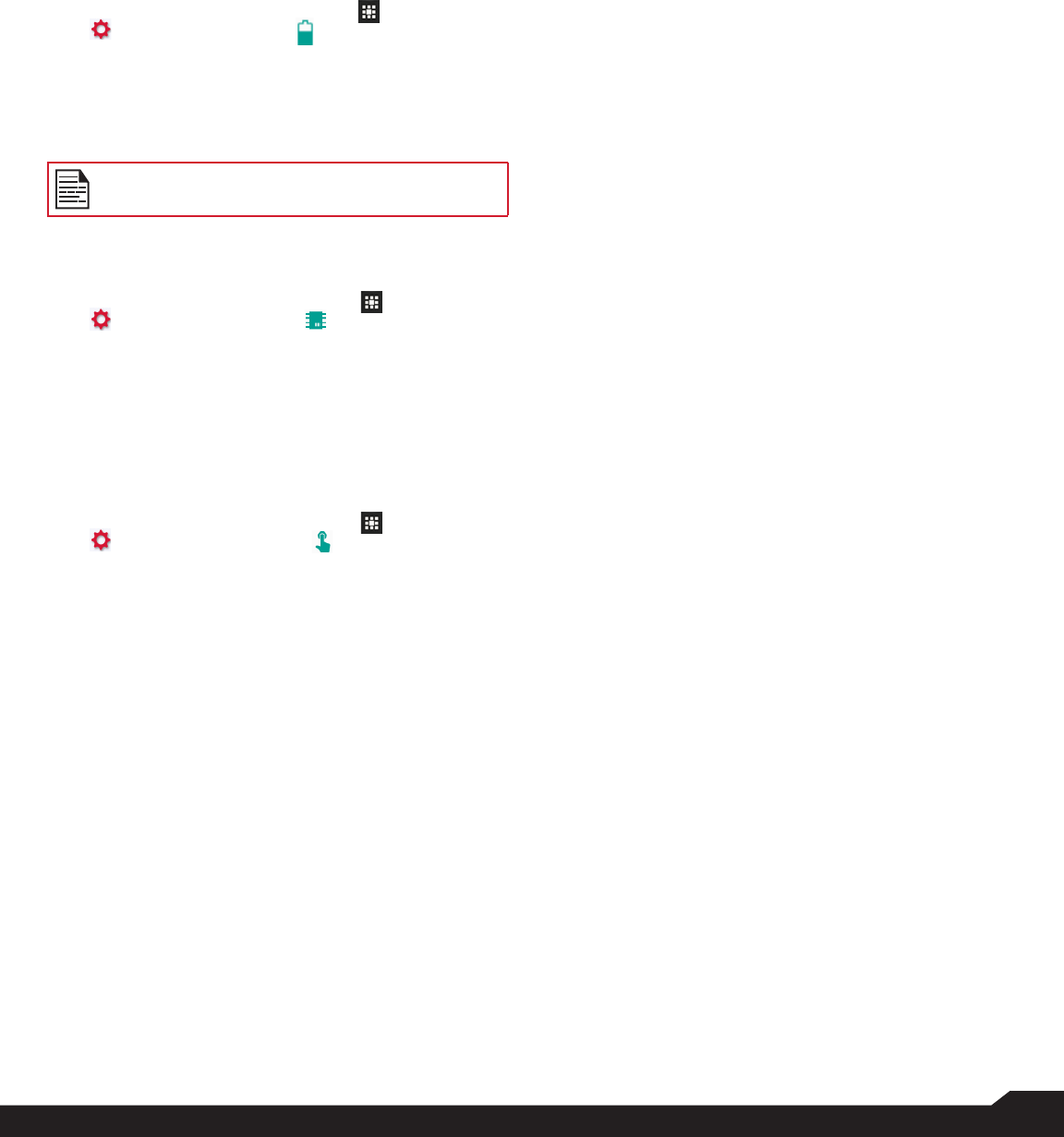
19
CONTENT
BATTERY
1. From Home screen, select Menu ( ) > Settings
( ) > Device > Battery ( ).
2. Set the Battery saver ON by selecting the option
given for Turn on automatically:
• Never
• at 5% battery
• at 15% battery
Battery saver turns off automatically when your
device is charging.
You can also view the battery usage data.
MEMORY
1. From Home screen, select Menu ( ) > Settings
( ) > Device > Memory ( ).
2. Go to App usage and select the time from the
drop-down list. You can view the applications
usage based on the set time frame.
3. Select Memory used by apps to check the
memory used for each application for the set time
frame.
GESTURES
1. From Home screen, select Menu ( ) > Settings
( ) > Device > Gestures ( ).
2. Enable Toggle Torch.
3. To quickly toggle torch, shake the device twice.
MANAGING DEVICE SETTINGS

20
MANAGING PERSONAL SETTINGS
MANAGING PERSONAL SETTINGS
HOME SCREEN SHORTCUTS
You can set the shortcuts on the home screen.
1. From Home screen, select Menu ( ) > Settings
( ) > Personal.
2. Select Home screen shortcuts ( ).
3. Go to the Navigation up key and selct the app to
be set for the up key navigation.
4. Go to the Navigation center key and selct the
app to be set for the center key navigation.
5. Go to the Navigation down key and selct the app
to be set for the down key navigation.
EMERGENCY INFO
You can enter the emergency information to be viewed
during an emergency.
1. From Home screen, select Menu ( ) > Settings
( ) > Personal.
2. Select Emergency Info ( ).
3. Go to My information and enter the following
details:
• First name
• Last name
• Phone number
• Email address
• Address
• Blood type
• Allergies
• Medication
• Organ donor
4. If you do not want to enter any of the above
details, select Skip.
5. Go to Add and you can select the contact from
the the phonebook by selecting Select contact.
OR
6. Select Add > Add new. Add First name, Last
name, and Phone number. Selcet Add.
Ths contact is added under Emergency contacts list.
LOCATION
You can enable and congure the Location settings.
1. From Home screen, select Menu ( ) > Settings
( ) > Personal.
2. Select Location ( ). Enable and modify
required security settings.
3. Enable Location.
4. Set the Location Mode to one of the following
options:
• High accuracy: uses AGPS, Wi-Fi, mobile
networks, and other sensors to get the highest-
accuracy location for your device. It uses location
services to help estimate your location faster and
more accurately.
• Battery saving: allows your device to estimate
your location using low battery-intensive location
sources, such as Wi-Fi and mobile networks.
It uses location services to help estimate your
location faster and more accurately.
• Device only: allows your device to estimate
your location using GPS only. It uses the satellite
information to provide location information. This
mode may use more battery power and take
longer to determine your location.
5. You can also view the apps which have requested
location recently under Recent location
requests.
SECURITY
You can activate and protect your phone from
unauthorized access by conguring the security settings.
1. From Home screen, select Menu ( ) > Settings
( ) > Personal.
2. Select Security ( ).
3. Select Device security > Screen lock and select
one of th efollowing options to congure the
phone:
• None
• Press and hold * key
• PIN: When enabled, enter you own PIN value. When
the phone is locked, unlock it using the PIN.
When the phone is locked, you can answer an
incoming call, without unlocking the phone.
4. Encryption: By default, the phone is already
encrypted.
5. Enable Passwords > Make password visible to
the password characters.
6. Device administration:
• Device administrators: You can view or deactivate
the device administrator.

21
MANAGING PERSONAL SETTINGS
• Unknown resources: When enabled, it allows
installing the apps from unkonwn sources.
7. Credential storage:
• Storage type: Displays the storage type.
• Trusted credentials: You can view and verify the
system and user certicates.
• Install from SD card: You can view and install new
user certicates from SD card.
• Clear credentials: You can remove all certicates.
8. Advanced:
• Trust agents: To use this option, a screen lock
should set.
• Apps with usage access: Select the app and select
center key to enable the Permit usage access.
LANGUAGE & INPUT
You can set the phone’s language to any of the
languages displayed in the language list.
1. From Home screen, select Menu ( ) > Settings
( ) > Personal.
2. Select Langauage & input ( ).
3. Go to Languages and select any language from
the list as your preferred language.
The following languages can be set as a preferred
language:
• English
• Espanol
All the menu items and user feedback messages will
get displayed in the set language.
4. Select Keyboard & input methods > FlexT9 Text
Input.
• Input language: You can set the input language to
either English or Espanol.
• Personal Dictionary: The default keyboard input
language is set to English (US)/Spanish (US) - T9
format. This cannot be modied.
• Preferences:
• Auto-capitalization: The rst letter of the new
sentence is automatically capitalized.
• Auto-punctuation: If this option is enabled, when
you press the space key twice at the end of the
word to insert a period.
• Language switch key: Press and hold the * key
to switch the language.
• New Word Prediction: Predeicts a new word
based on the previous word entered.
• Suggest contact names: Displays suggested
contact while typing.
5. Select Supprt > FlexT9 Help.It displays FlexT9
help guide.
Select Support > About. It displays the FlexT9 version
details.
6. Select Speech > Text-to-speech output. You can set
and reset the Speech rate and Speech Pitch.
FACTORY RESET
You can erase all the data from your phone’s internal storage.
1. From Home screen, select Menu ( ) > Settings (
) > Personal.
2. Select Fatory Reset ( ).
3. You can rase all data from your phone’s internal
storage which includes;
• System and app data and settings
• Downloaded apps
• Music
• Photos
• Other user data

22
MANAGING SYSTEM SETTINGS
can see the text changes into the contrast colors.
• Mono Audio: Enable Mono audio to combine the
channels when playing audio.
• Sound balance:
• Accessibility shortcut: When set to ON, you can
have a shortcut on the home screen.
• Text-to-speech output:
• Preferred engine: The preferred engine is set.
• General: You can adjust the Speech rate and
Pitch. Reset the speech rate and speech pitch.
You can demonstrate a speech synthesis. English
is set as default language status.
• Press & hold delay: You can set the duratin of
press & hold delay:
• Short
• Medium
• Long
ABOUT PHONE
1. From Home screen, select Menu ( ) > Settings
( ) > System.
2. Select About phone ( ).
3. Go to Software Update and Check for Updates.
If there is any updates, it starts updating.
4. The following information is displayed:
• Status
• Legal Information
• Model
• Firmware version
• Firmware security patch level
• Baseband version
• Kernel version
• Build number
MANAGING SYSTEM SETTINGS
DATE & TIME
You can set and display the date and time on the phone.
You can also select the display format.
1. From Home screen, select Menu ( ) > Settings
( ) > System.
2. Select Date & time ( ).
3. Select the following options to congure phone:
• To synchronize the date and time with the network
provided time, enable Automatic date & time.
• To synchronize the time zone with the network
provided time enable, Automatic time zone.
• To set the date manually, select Set date. Scroll and
select the date, month and year. Select Done.
• To set the time manually, select Set time. Scroll and
select the hour and minute. Select Done.
• To set the time zone, select Select time zone. Scroll
and select your time zone.
• To set the clock to 24-hour format enable Use
24-hour format. By default, the phone is set to
12-hour format.
ACCESSIBILITY
You can make websites and applications more
accessible to people with disabilities when they are using
mobile phones and other devices.
1. From Home screen, select Menu ( ) > Settings
( ) > System.
2. Select Accessibility ( ).
3. Select Services.
• AetherPal MSM:
• Talkback: When Talkback is enabled, it helps
vision-impaired users interact with their devices.
It uses spoken word, vibration and other audible
feedback to let you know what’s on your screen,
what you’re touching, and what you can do with it.
4. Select System.
• Captions: When Captions is ON, you can set the
following options under Standard options:
• Language
• Text size
• Caption style
• Font size: You can set the font size from smaller to
bigger and see the preview of the same.
• High contrast text: If this option is enabled, you
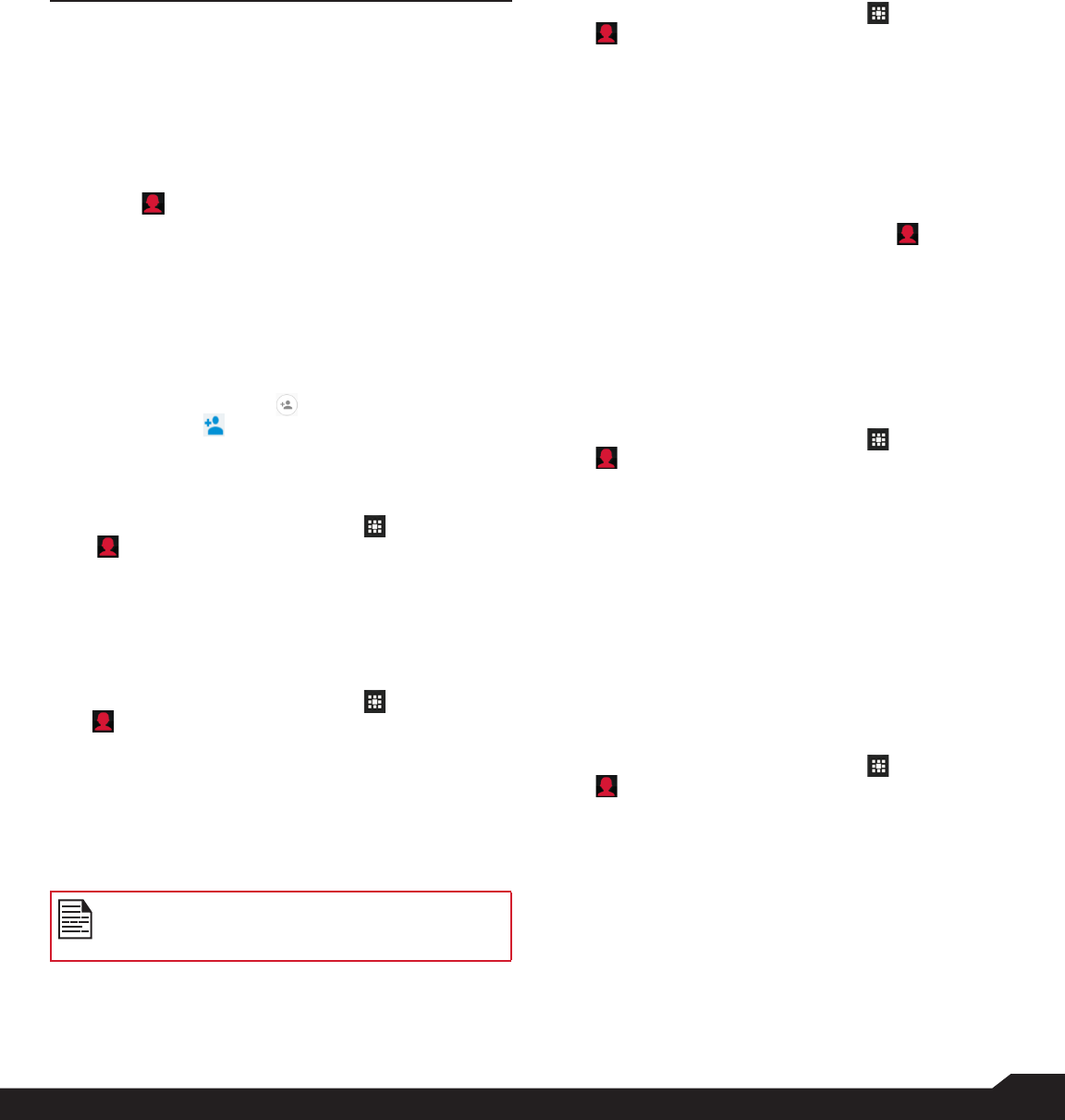
23
MANAGING CONTACTS
MANAGING CONTACTS
You can use the phonebook to maintain
phone numbers of your contacts. This
feature enables you to add, dial phone
numbers and send SMS and MMS
messages.
To access the contacts, from Home screen, select
Contacts ( ). The contacts saved in the phonebook
are displayed.
ADDING A NEW CONTACT
1. To add a new contact, select Menu > Contacts >
Add contact. Enter the contact details and select
Option key > Save to save the contact.
2. You can also enter a number using dialpad and
select Add to contact ( ) and then Create
new contact ( ) to add a new contact. Select
Option key > Save to save the contact.
VIEWING CONTACT DETAILS
1. From Home screen, select Menu ( ) > Contacts
( ).
2. Scroll to the required contact and select the
contact to view the contact details.
SENDING A MESSAGE FROM CONTACTS
You can send SMS and MMS messages to te contacts.
1. From Home screen, select Menu ( ) > Contacts
( ).
2. Scroll to the required contact and open it.
3. Select Option key > Send message.
4. Enter the message and select Option key >
Attach photos/videos to attach the photos and
videos.
5. Select Option key > Send.
If you attach a media le or a contact to your
SMS message it is converted to an MMS
message automatically.
DIALING A NUMBER FROM CONTACTS
1. From Home screen, select Menu ( ) > Contacts
( ).
2. Scroll to the required contact and select the
contact to view the details.
3. Select the number and press Center key initiate
the call.
4. Select the required contact from the list and press
the green button on the phone to initiate the call.
EDITING THE CONTACT DETAILS
1. From Home screen, select Contacts ( ).
2. Scroll to the required contact and select the
contact to view the details.
3. Select Option key > Edit.
4. Edit the required details. Select Option key >
Save to save the details.
IMPORTING SIM CARD CONTACTS TO
PHONE
1. From Home screen, select Menu ( ) > Contacts
( ).
2. Select Option key > Import/export.
3. Select Import from SIM card.
The list of contacts stored in your SIM card are
displayed.
4. Select the contact to be moved to the phone.
5. Select Option key > Done.
6. A conrmation message is displayed. Select OK
to conrm.
The contact is imported to the phone address.
EXPORTING PHONE CONTACTS TO SIM
CARD
1. From Home screen, select Menu ( ) > Contacts
( ).
2. Select Option key > Import/export.
3. Select Export to SIM card.
4. Select the contact to be exported from Phone to
SIM card.
5. Select Option key > Done.
The contact is exported to the SIM card.

24
MANAGING CONTACTS
EXPORTING PHONE CONTACTS TO
STORAGE
1. From Home screen, select Menu ( ) > Contacts
( ).
2. Select Option key > Import/export.
3. Select Export to .vcf le.
4. Press Center key to select the contact to be
exported.
5. Select Option key > Done.
A message is displayed to select the source to save
the .vcf le.
SHARING CONTACT VIA MMS AND
BLUETOOTH
You can send contact information in following 3 ways:
1. From Home screen, select Menu ( ) > Contacts
( ).
2. Scroll to the required contact and select the
contact and press center key to open the contact
details.
3. Select Option key > Share. You can use one
of the following options to share the required
contact:
• Bluetooth: Send the contact details to a
Bluetooth device paired with your phone. Select
the Bluetooth device to share the contact.
• PSX Messenger:
• Messaging: Send the contact details as a
multimedia message to any mobile phone.
MANAGING CONTACT SETTINGS
You can edit and modify ringtone and call receiving
settings for individual contacts.
1. From Home screen, select Menu ( ) > Contacts
( ).
2. Scroll to the required contact and select the
contact to view the contact details.
3. Select Options key and select one of the
following:
• Set Ringtone to set a specic ringtone for that
contact.
• Check the option All calls to voicemail to forward
all incoming calls from that contact to your voice-
mail box.
MANAGING PHONEBOOK SETTINGS
You can set the sort list to view the contacts and also the
rst or last name of the contact to be displayed rst.
1. From Home screen, select Menu ( ) > Contacts
( ).
2. Select Options key > Settings. Set the following
options:
• Sort by: Sort the contact names by rst name or
last name.
• Name format: Set the contact display name to
rst name or last name.
DELETING A CONTACT
1. From Home screen, select Menu ( ) > Contacts
( ).
2. Scroll to the required contact and select the
contact to view the contact details.
3. Select Options key > Delete or press Clear ( )
key. The contact is deleted after the conrmation.

25
MANAGING CALL SETTINGS
MANAGING CALL SETTINGS
MAKING A CALL
1. From Home screen, select Phone ( ).
The phone screen with last dialed number, missed
calls and received calls are displayed with arrow
marks in different colors (missed call - Red, Dialed
number - two arrow marks green color, Received call
- one arrow mark green color).
DIALING A NUMBER VIA CONTACT
1. From Home screen, select Menu ( ) > Contacts
( ).
2. Scroll to the contact and select the contact. The
contact details are displayed.
3. Select the required phone number to call the
contact.
ADDING A CONTACT FROM HOME SCREEN
1. From Home screen, enter the required number to be
dialed.
2. Select Add to contact ( )
3. Select Create new contact ( ).
4. In the Add new contact screen, add the name
and other details for the contact.
5. Select Option key > Save.
The contact is saved.
VIEWING CALL HISTORY
1. From Home screen, select Phone ( ).
2. The Recent calls screen displayed with recently
called, received, and missed calls.
DELETING CALL HISTORY
1. From Home screen, select Phone ( ).
2. On the Recent calls screen, select Option key >
Delete selected call log.
3. A conrmation message is displayed to delete the
selected call log. Select Delete to delete the call
log.
The selected call log is deleted.
MANAGING CALL SETTINGS
You can change the incoming call ringtone, enable
vibrate when ringing and enable audible press tone.
To view and modify call settings,
1. From Home screen, select Phone ( ).
2. On Recent calls screen, select Option key > Call
settings. Different settings are:
QUICK RESPONSES:
When you are not able to answer an incoming call, you
can send a quick response to the caller. To view and
edit quick responses, select Call settings > Quick
responses. Select the specic response message to
edit. Edit the message and select OK.
CALLING ACCOUNT:
• Setting:
• Display duration: Set this option to ON to keep
the screen display on during the call.
• Vibrating after connected: Set this option to ON
to keep the device vibrating after connected.
• Smart-Divert: Subscription should be activated to
process Smart-Divert.
SIP SETTINGS
SIP Accounts:
To add a SIP account and congure your incoming and
outgoing preferences:
1. In the Call settings screen, select SIP accounts.
2. Enable Receive incoming calls to answer
incoming Internet calls.
This might reduce your phone’s battery life.
3. Select Option key > Add account to congure a
new SIP account.
4. Enter the following details and select Option key
> Save to save the account:
• Username: Username to login to SIP account.
• Password: Password to login to SIP account.
• Server: SIP server details.
• Optional Settings: Select to view/modify or hide
optional details such as authentication username,
display name, outbound proxy address, port
number, transport type and Send keep alive
options.

26
MANAGING CALL SETTINGS
USE SIP CALLING
1. Select Calling accounts > Use SIP calling.
2. A dialog is open with the following options:
• For all calls: If this option is selected and when
the phone is connected to Wi-Fi network or mobile
Internet, each dialed call becomes an Internet call.
• Only for SIP calls: If this option is selected, only SIP
call can be dialed.
RECEIVE INCOMING CALLS
Enable Receive incoming calls to answer incoming
Internet calls.
This might reduce your phone’s battery life.
CALL BLOCKING:
You will not receive calls or messages from the blocked
numbers.
CHANGING RINGTONES AND MASTER
VOLUMES
1. From Home screen, select Menu ( ) > Settings
( ).
2. Select Proles ( ) located under Device.
The prole types are:
• Standard
• Outdoor
• Silence
• Meeting
3. Select any of the proles. Select Option key >
Edit.
4. Select Option key > Save to change the settings.
SPEED DIAL SETTINGS
1. From Home screen, select Phone ( ).
2. Select Option key > Speed dial settings.
3. Assign a contact for each key present in the
keypad (1 to 9).
4. Press a particular keypad to initiate a call to the
assigned contact.
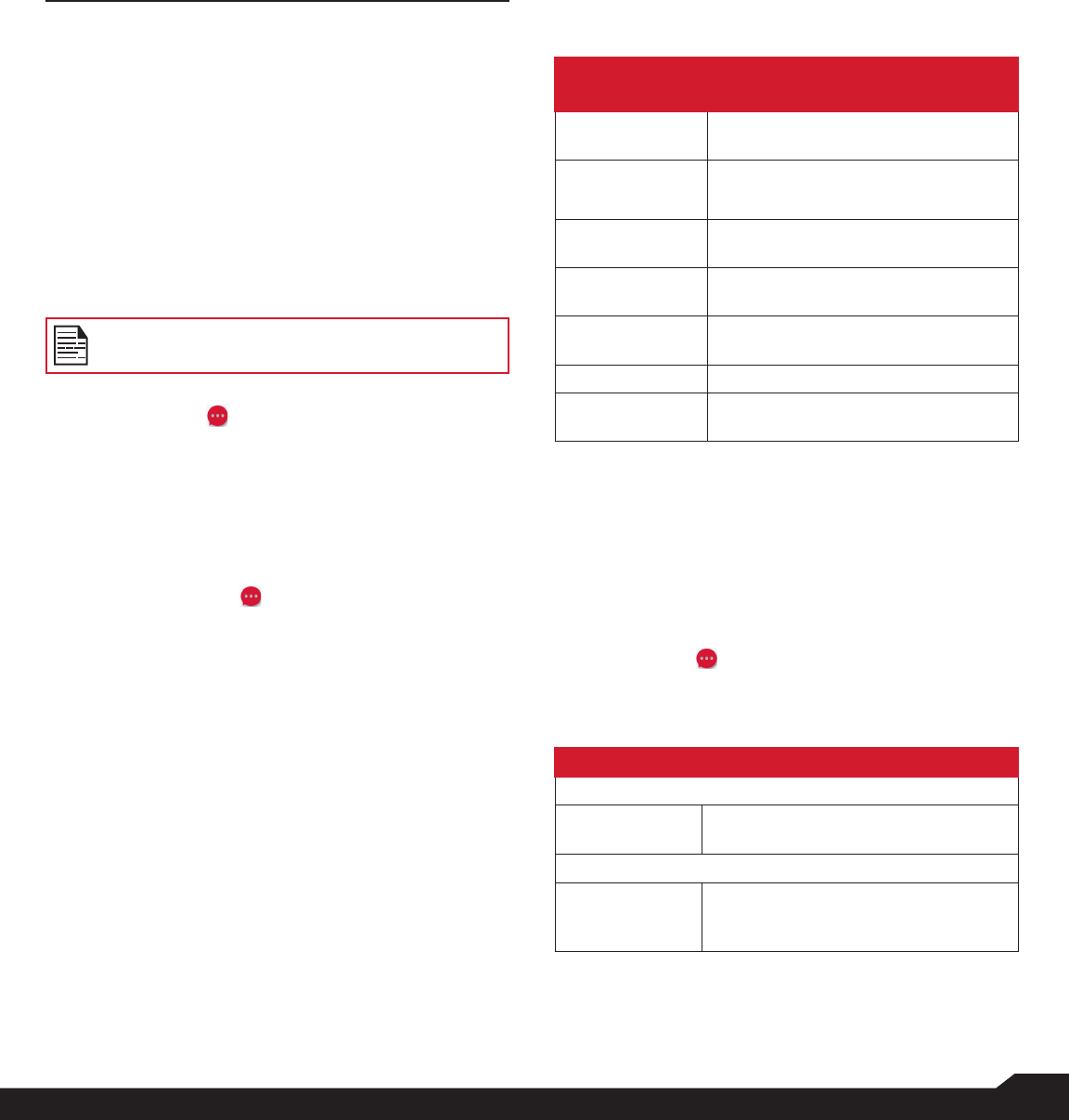
27
SENDING MESSAGES
SENDING MESSAGES
SMS and MMS are convenient and
inexpensive means of communication.
You can send a text message to other
people via SMS service. MMS allows
you to send messages by including
multimedia content such as pictures,
audio les, video les, and so on.
You can use the Messaging in your phone to send an
SMS and MMS message to other mobile phones or any
other equipment that can receive SMS and MMS.
The MMS feature is available only if you
subscribe it from your network operator.
To access the message function, from Home screen,
select Messaging ( ).
SENDING SMS/MMS MESSAGE
You can send SMS and MMS messages to contacts
in your phonebook and to new numbers that are not
present in the phonebook.
1. To create a SMS message, from Home screen,
select Messaging ( ).
2. Select Option key > New message.
3. Enter the contact name or the phone number in
the To eld.
If you enter an alphabet, all the contact names
starting with that alphabet and containing that
alphabet are displayed as a list. Scroll down to
select the contact.
4. Enter the message.
When you add an attachment, the message is
automatically converted to a multimedia message.
MMS charges will apply, based on the operator.
5. You can add any multimedia attachment up to
the size of <= 5 MB. To add an attachment, select
Options key > Attach photos/videos. Select the
attachment type from the options in the next step.
6. Select Option key > Attach others. Browse to a
specic folder and select the multimedia le to be
attached.
7. thread is deleted after the conrmation.
8. Tap on Delete to delete the thread.
To delete an individual conversation, select the
converstion to be deleted and tap on Delete option and
conrm the choice.
ATTACHMENT
TYPE
DESCRIPTION
Capture picture Take a new photo using the mobile
camera and attach.
Capture video Take a new video using the
camcorder and attach.
Audio Attach an audio le from the phone
memory.
Record audio Record a new audio using the sound
recorder and attach.
vCard Attach a contact available in the
phone.
vCalendar Attach a calendar event.
Slideshow Create new slideshow or edit the
existing slides and attach.
MANAGING MESSAGE SETTINGS
You can customize the way you want to view and lter
the messages. You can also set the default messaging
application.
To view and modify the message settings,
1. To edit message settings, from Home screen, select
Messaging ( ).
2. Select Option key > Settings.
3. View and edit the following settings:
SETTINGS DESCRIPTION
NOTIFICATION
Vibrate Enable vibrate alert for incoming
messages.
DISPLAY
Group
notication
message
Enable this notication message to
auto combine the notication into
one group.
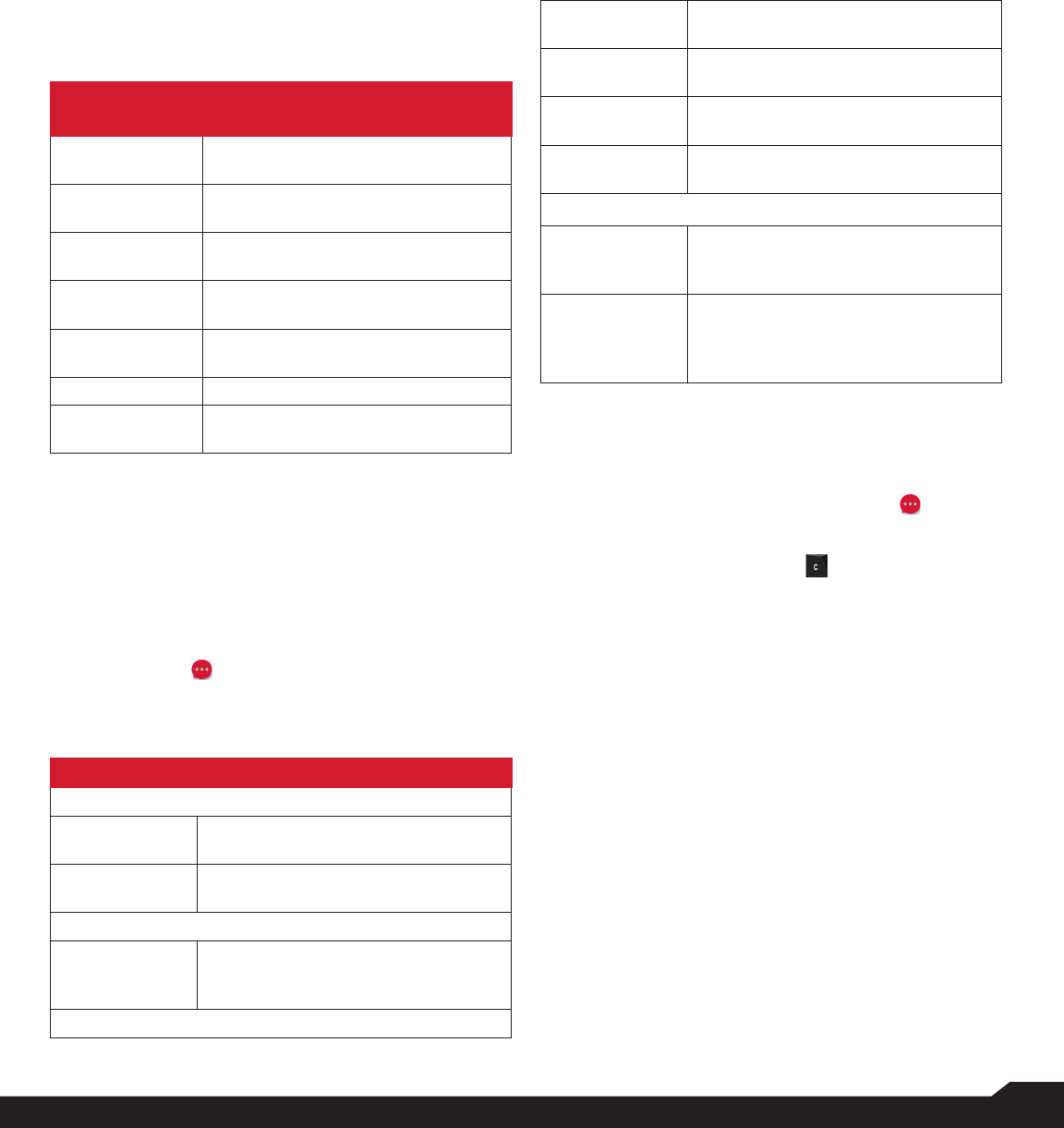
28
SENDING MESSAGES AND E-MAILS
To delete an individual conversation, select the
converstion to be deleted and tap on Delete option and
conrm the choice.
ATTACHMENT
TYPE
DESCRIPTION
Capture picture Take a new photo using the mobile
camera and attach.
Capture video Take a new video using the
camcorder and attach.
Audio Attach an audio le from the phone
memory.
Record audio Record a new audio using the sound
recorder and attach.
vCard Attach a contact available in the
phone.
vCalendar Attach a calendar event.
Slideshow Create new slideshow or edit the
existing slides and attach.
MANAGING MESSAGE SETTINGS
You can customize the way you want to view and lter
the messages. You can also set the default messaging
application.
To view and modify the message settings,
1. To edit message settings, from Home screen, select
Messaging ( ).
2. Select Option key > Settings.
3. View and edit the following settings:
SETTINGS DESCRIPTION
NOTIFICATION
Vibrate Enable vibrate alert for incoming
messages.
Pop- Enable to view received message as
a pop-up.
DISPLAY
Group
notication
message
Enable this notication message to
auto combine the notication into
one group.
STORAGE
Delete old
messages
Delete old messages automatically
when the storage limit is reached.
Text message
limit
Set the maximum number of SMS
messages to be stored.
Multimedia
message limit
Set the maximum number of MMS
messages to be stored.
Memory status Shows the memory used for SMS,
MMS and the total memory used.
ADVANCED SETTINGS
Text (SMS)
messages
settings
Multimedia
(MMS)
messages
settings
DELETING MESSAGES
To delete all the messages,
1. From Home screen, select Messaging ( ).
2. Select the message and press Option key >
Delete selected thread or select a message
thread and press Clear key ( )
3. A conrmation message is displayed. Select
Delete to delete the selected message.
EMERGENCY ALERTS
You receive active alerts and emergency alerts from the
service provider.

29
USING THE KEYBOARD / PSX PTT SERVICES
USING THE KEYBOARD
You can view and modify the language
and dictionary setting using the Phone
Settings.
ENTER AND EDIT TEXT
You can use the phone keypad to enter the text quickly
and easily. Type faster and more accurately on your
device with Keypad’s word recognition and next-word
predictions.
The key features are:
• Personalized suggestions, corrections, and
completions
• Emoji entry point and layouts.
PHONE DICTIONARIES
To manage phone dictionaries:
1. From Home screen, select Menu ( ) > Settings
( ).
2. Select Language & input ( ) located under
Personal settings.
PERSONAL DICTIONARY
You can add your own words to your personal dictionary
so that your device remembers them.
To add a word or phrase, including an optional shortcut,
1. Select Language & input ( ) located under
Personal settings.
2. Select FlexT9 Text Input located under
Keyboard & input methods.
3. Select Personal dictionary > Options key > Add.
4. Add a required word and respective shortcut
which is optional.
PSX PTT SERVICES
Your Sonim phone comes with pre-loaded
PSX PTT application.
LAUNCHING PSX PTT APPLICATION
Select the PTT button on the side of the XP5 phone or
select the PTT icon on the panel of the Home screen to
launch the PTT+ application.
<EXTERNAL LINK - MSI WEBSITE>

30
SONIM SETUP WIZARD / USING APPLICATIONS
SONIM SETUP WIZARD
This is an application that can be used to
provision the phone in conjunction with
a web based utility at www.sonimcloud.
com.
INTRODUCTION
Sonim’s device provisioning solution consists of a
Web based utility and SonimSetupWizard application
to provision a set of devices added under a specic
corporate account.
Using the web based utility, you can:
• Setup provisioning resources such as Wi-Fi, VPN,
Applications, Sounds, Admin packages, Bookmarks
and Contacts.
• Create a provisioning prole for a specic device
group with required resources
• Generate a QR code for a specic prole and
provision the devices.
USING APPLICATIONS
CAMERA
The Sonim XP5s has a rear camera with 5MP xed focus
for taking pictures. The pictures are saved in the Gallery.
1. From Home screen, select Menu ( ) > Camera
( ).
2. Select Camera mode to set the following modes:
• Normal ( ): To shoot a picture in normal mode,
press center key to capture the picture. Use Left
and Right navigation keys for Zoom in and Zoom
out.
• Video ( ): Press center key to start/stop a
video recording.You cannot pause the recording
in the middle.
3. Select Option key to view or change camera
settings such as Flash, Exposure, and File
Format etc.
CALENDAR
The Calendar helps you to set appointments, schedule
reminders and alerts and repeat them if required. You can
also view your saved tasks on a daily or weekly basis.
To access calendar;
1. From Home screen, select Menu ( ) > Calendar
( ).
2. To change the calendar view, choose Month or
Agenda from Options menu.
3. Select Options key to view the list of the following
available options:
• Today: Access current date events.
• New event: New event can be added on selecting
this option.
• Agenda: Select each agenda and to view the event
details.
• Search: You can search for a particular event.
• Delete Events: Select the event > Option key >
Done to delete the selected event. Select Select all
to delete all the events.
When you have a event the Delete event option is
enabled.
• Settings: Displays the General settings of the
calendar.

31
USING APPLICATIONS
CLOCK
You can view the time of major cities in different time
zones using this function. You also have the option to use
Daylight Saving Time (DST).
1. From Home screen, select Menu ( ) > Tools( ).
2. Select Clock ( ).
3. Select World clock icon ( ) located on the top
of the screen. To add a city , select Option key >
Add city. Select the check box next to the city to
add them to the Clock.
Added cities are listed in alphabetical order.
• The local time in the home city is displayed in the
upper half of the screen.
• To set the home city, select the required city from
the list. It is added to the selected cities list. The
selected city is set as the home city.
ALARM
You can set an alarm for a particular time.
1. From Home screen, select Menu ( ) > Tools( ).
2. Select Clock ( ).
3. Select Alarm activation icon ( ) on the top of
the screen.
4. Select Option key > Add to add a new alarm.
5. To set a recurring alarm, select Option key > Edit
> Repeat. Select the days for repeating the alarm
and select Done.
6. Select any of the ringtones from the Default
alarm tone sound present, and select OK.
7. Select Option key > Save to save the changes.
The alarm will work even when the phone is set
in silent mode.
STOPWATCH
1. From Home screen, select Menu ( ) > Tools ().
2. Select Clock ( ) > Stop watch ( ).
3. Select START and STOP to run the stop watch.
TIMER
1. From Home screen, select Menu ( ) > Tools ().
2. Select Clock ( ) > Timer ( ).
3. The following actions can be performed:
• RESET
• START
• STOP
• LAP
CALCULATOR
The default calculator in this phone is designed to perform
simple mathematical calculations.
1. From Home screen, select Menu ( ) > Tools( ) >
Calculator ( ) .
• To enter the numbers, select the numeric keys.
• To use mathematical operators, select the respective
operation key on the keypad.
• Select = for the nal results.
SOUND RECORDER
You can record voice memos using the sound recorder.
To access the sound recorder,
1. From Home screen, select Menu ( ) > Tools( ) >
Sound Recorder ( ) .
• To record an audio le, select Record ( ).
• To stop the recording, select Stop ( ).
• To save the voice memo, press left arrow key and
select Save.
• To exit without saving, press left arrow key and select
Discard.
• To play the recorded le instantly, press right arrow
key and select the le to be played. Press center key
to play the voice memo.
MUSIC
You can play music les and voice memos stored in your
phone using the music application.
From Home screen, select Menu ( ) > Applications
( ) > Music ( ) .
• Select Artists to view the music les sorted based on
the artists.
• Select Albums to view the music les sorted based
on the albums.
• Select Songs to view the complete list of songs
stored in your phone.
• Select Playlists to access the default playlists in the
music folder.
• Select Recently added playlist to view the music
les that are recently added to the music folder.
• Select My recordings playlist to access all your
voice memo les.

32
USING APPLICATIONS
FM RADIO
You can listen to the radio through FM radio. A wired Headset
should be connected to enabling FM radio.
To listen to the radio, select Menu ( ) > Applications (
) > FM Radio ( ) .
Insert wired Head Set > Options > Radio ON.
• Select Auto scan to scan all the available frequency.
• Select Add to presets to add the selected channel to the
favorite.
• Select Settings to change the FM settings.
• Select Sleep to automatically off the radio after the set
time.
• Select Radio off to stop the radio playing.
• Select Loud speaker to enable FM play through the
speaker.
• Select Options > Presets > Option > Rename and edit
the preset channels.
• Select Start recording allow the user to record current
playing FM and save the le.
If user removes the wired headset during FM play, FM will be
stopped.
FILE EXPLORER
You can view/edit/delete/share the les stored in the phone
through File Explorer ( ).
To view the les, select Menu ( ) > Applications ( ) >
File Explorer ( ).
Following are the options:
• Recent: Displays the recent les captured or stored.
• Downloads: Displays the downloaded les.
• XP5800: Displays the different folder in the device drive.
By default, Internal Storage and SD card options are available
under Storage.
Select Internal storage and the list of default folders are
displayed:
• User can create new folder using New option.
• User can copy/move the contents of folder using Copy/
Move options.
• User can delete the existing folder using Delete option.
• User can share the folder contents via Bluetooth and
message using Share option.
• User can rename the existing folder name using Rename
option.
• User can view the properties of folder using Properties
option.
• User can select Exit option for exiting from current folder.
If SD card is inserted, all the les in the SD card can be view/
edit/delete/share from le explorer.

33
REGULATORY INFORMATION - USA MARKET
REGULATORY INFORMATION - USA
MARKET
RF EXPOSURE INFORMATION (SAR)
This device meets the government’s requirements for
exposure to radio waves.
This device is designed and manufactured not
to exceed the emission limits for exposure to
radio frequency (RF) energy set by the Federal
Communications Commission of the U.S. Government.
The exposure standard for wireless device employs a
unit of measurement known as the Specic Absorption
Rate, or SAR. The SAR limit set by the FCC is 1.6W/
kg. *Tests for SAR are conducted using standard
operating positions accepted by the FCC with the
device transmitting at its highest certied power level
in all tested frequency bands. Although the SAR is
determined at the highest certied power level, the
actual SAR level of the device while operating can
be well below the maximum value. This is because
the device is designed to operate at multiple power
levels so as to use only the poser required to reach the
network. In general, the closer you are to a wireless
base station antenna, the lower the power output.
The highest SAR value for the model device XP5800
(Type number PC2111) as reported to the FCC:
• when tested for use at the ear is 0.98W/kg, and
• when worn on the body, as described in this user
guide, is 1.35W/kg (Body-worn measurements
differ among device models, depending upon
available accessories and FCC requirements.)
While there may be differences between the SAR levels
of various devices and at various positions, they all
meet the government requirement.
The FCC has granted an Equipment Authorization for
this model device with all reported SAR levels evaluated
as in compliance with the FCC RF exposure guidelines.
SAR information on this model device is on le with the
FCC and can be found under the Display Grant section
of www.fcc.gov/oet/ea/fccid after searching on FCC ID:
WYPPC2100.
For body worn operation, this device has been tested
and meets the FCC RF exposure guidelines for use with
an accessory that contains no metal and be positioned
a minimum of 1.5cm from the body. Use of other
accessories may not ensure compliance with FCC RF
exposure guidelines. If you do not use a body-worn
accessory and are not holding the device at the ear,
position the handset a minimum of 1.5cm from your
body when the device is switched on.
FEDERAL COMMUNICATION COMMISSION
INTERFERENCE STATEMENT
This device complies with part 15 of the FCC Rules.
Operation is subject to the following two conditions:
• This device may not cause harmful interference, and
• This device must accept any interference received,
including interference that may cause undesired
operation.
This device has been tested and found to comply with
the limits for a Class B digital device, pursuant to Part 15
of the FCC Rules. These limits are designed to provide
reasonable protection against harmful interference in a
residential installation. This equipment generates, uses,
and can radiate radio frequency energy, and, if not
installed and used in accordance with the instructions,
may cause harmful interference to radio communications.
However, there is no guarantee that interference will
not occur in a particular installation If this equipment
does cause harmful interference to radio or television
reception, which can be determined by turning the
equipment off and on, the user is encouraged to try to
correct the interference by one or more of the following
measures:
• Reorient or relocate the receiving antenna.
• Increase the separation between the equipment
and receiver.
• Connect the equipment into an outlet on a
circuit different from that to which the receiver is
connected.
• Consult the dealer or an experienced radio/TV
technician for help.
FCC CAUTION
• Any Changes or modications not expressly
approved by the party responsible for compliance
could void the user‘s authority to operate the
equipment.
• The antenna(s) used for this transmitter must not
be co-located or operating in conjunction with any

34
REGULATORY INFORMATION - USA MARKET
a minimum of 1.5cm from the body. Use of other
accessories may not ensure compliance with FCC RF
exposure guidelines. If you do not use a body-worn
accessory and are not holding the device at the ear,
position the handset a minimum of 1.5cm from your
body when the device is switched on.
FEDERAL COMMUNICATION COMMISSION
INTERFERENCE STATEMENT
This device complies with part 15 of the FCC Rules.
Operation is subject to the following two conditions:
• This device may not cause harmful interference, and
• This device must accept any interference received,
including interference that may cause undesired
operation.
This device has been tested and found to comply with
the limits for a Class B digital device, pursuant to Part 15
of the FCC Rules. These limits are designed to provide
reasonable protection against harmful interference in a
residential installation. This equipment generates, uses,
and can radiate radio frequency energy, and, if not
installed and used in accordance with the instructions,
may cause harmful interference to radio communications.
However, there is no guarantee that interference will
not occur in a particular installation If this equipment
does cause harmful interference to radio or television
reception, which can be determined by turning the
equipment off and on, the user is encouraged to try to
correct the interference by one or more of the following
measures:
• Reorient or relocate the receiving antenna.
• Increase the separation between the equipment
and receiver.
• Connect the equipment into an outlet on a
circuit different from that to which the receiver is
connected.
• Consult the dealer or an experienced radio/TV
technician for help.
FCC CAUTION
• Any Changes or modications not expressly
approved by the party responsible for compliance
could void the user‘s authority to operate the
equipment.
• The antenna(s) used for this transmitter must not
be co-located or operating in conjunction with any
• other antenna or transmitter.
• The country code selection is for non-US model
only and is not available to all US model. Per FCC
regulation, all Wi-Fi product marketed in US must
xed to US operation channels only.
• Operations in the 5.15-5.25GHz band are
restricted to indoor usage only.
ISED RF EXPOSURE STATEMENT (IC)
This EUT is compliance with SAR for general
population/uncontrolled exposure limits in IC RSS-
102 and had been tested in accordance with the
measurement methods and procedures specied in
IEEE 1528 and IEC 62209. This equipment should be
installed and operated with minimum distance 1.5 cm
between the radiator and your body. This device and
its antenna(s) must not be co-located or operating in
conjunction with any other antenna or transmitter.
Cet appareil est conforme aux limites d’exposition DAS
incontrôlée pour la population générale de la norme
CNR-102 d’Industrie Canada et a été testé en conformité
avec les méthodes de mesure et procédures spéciées
dans IEEE 1528 et IEC 62209. Cet appareil doit être
installé et utilisé avec une distance minimale de 1.5cm
entre l’émetteur et votre corps. Cet appareil et sa ou ses
antennes ne doivent pas être co-localisés ou fonctionner
en conjonction avec tout autre antenne ou transmetteur.
HAC RATING
The FCC has created a rating system for cellular phones
regarding their HAC-related performance. This rating
helps consumers with hearing disabilities to nd phones
that work well with their hearing aid devices. The HAC
rating and measurement procedure are described in the
American National Standards Institute (ANSI C63.19-
2011) contains two rating standards: an “M” rating from
1 to 4 for hearing aids operating in microphone mode,
and a “T” rating from 1 to 4 for hearing aids operating in
tele coil mode. M-Rating stands for Microphone rating
and indicates the amount of reduction of RF interference
between the telephone and the hearing aid in acoustic
coupling mode (also called microphone mode). Phones
rated M3 or M4 meet FCC requirements and generate
less interference to hearing devices set in microphone
mode. T-Rating stands for tele coil rating and represents
inductive coupling with hearing aids that are operating in
telecoil mode. A tel coil is a small piece of tightly wrapped
wire, built into some hearing aids. While the

35
REGULATORY INFORMATION - USA MARKET
other antenna or transmitter.
• The country code selection is for non-US model
only and is not available to all US model. Per FCC
regulation, all Wi-Fi product marketed in US must
xed to US operation channels only.
• Operations in the 5.15-5.25GHz band are restricted
to indoor usage only.
ISED RF EXPOSURE STATEMENT (IC)
This EUT is compliance with SAR for general population/
uncontrolled exposure limits in IC RSS-102 and had been
tested in accordance with the measurement methods
and procedures specied in IEEE 1528 and IEC 62209.
This equipment should be installed and operated with
minimum distance 1.5 cm between the radiator and
your body. This device and its antenna(s) must not be
co-located or operating in conjunction with any other
antenna or transmitter.
Cet appareil est conforme aux limites d’exposition DAS
incontrôlée pour la population générale de la norme
CNR-102 d’Industrie Canada et a été testé en conformité
avec les méthodes de mesure et procédures spéciées
dans IEEE 1528 et IEC 62209. Cet appareil doit être
installé et utilisé avec une distance minimale de 1.5cm
entre l’émetteur et votre corps. Cet appareil et sa ou ses
antennes ne doivent pas être co-localisés ou fonctionner
en conjonction avec tout autre antenne ou transmetteur.
HAC RATING
The FCC has created a rating system for cellular phones
regarding their HAC-related performance. This rating
helps consumers with hearing disabilities to nd phones
that work well with their hearing aid devices. The HAC
rating and measurement procedure are described in the
American National Standards Institute (ANSI C63.19-
2011) contains two rating standards: an “M” rating from
1 to 4 for hearing aids operating in microphone mode,
and a “T” rating from 1 to 4 for hearing aids operating in
tele coil mode. M-Rating stands for Microphone rating
and indicates the amount of reduction of RF interference
between the telephone and the hearing aid in acoustic
coupling mode (also called microphone mode). Phones
rated M3 or M4 meet FCC requirements and generate less
interference to hearing devices set in microphone mode.
T-Rating stands for tele coil rating and represents inductive
coupling with hearing aids that are operating in telecoil
mode. A tel coil is a small piece of tightly wrapped
The model XP5800 have been tested for hearing aid wire,
built into some hearing aids. While the microphone of a
hearing aid picks up all sounds, the telecoil only picks up
an electromagnetic signal from the telephone. Thus, users
of telecoil-equipped hearing aids are able to communicate
over the telephone without the amplication of unwanted
background noise. Phones rated T3 or T4 meet FCC
requirements and generate less interference to hearing
devices set in telecoil mode. A combination of M-rating
and T-rating denes the nal HAC rating and is a deciding
factor in selecting cellular phones for people with hearing
problems. A HAC compliant phone could be rated:
• M3/T3
• M3/T4
• M4/T3
• M4/T4
These ratings assist hearing device users to nd
phones that are compatible with their hearing devices.
Ratings are shown on the phone’s box or label. The
ratings are not guaranteed for suitability. The results
vary depending on the individual’s hearing loss and the
immunity characteristics of the used hearing device, i.e.
its resistance to interference. The best way to evaluate the
suitability of the phone is to try it with the intended hearing
aid device.
The model XP5800 have been tested for hearing aid
device compatibility and complies with the Federal
Communications Commission (FCC) requirements.
These devices are rated M3/T4.

36
INDEX
1.
A
Account Sync 25
Airplane Mode 16
Alarm 31
All applications icon 12
Applications 30
B
Backup 21
Battery usage
Charging 7
Optimize power 8
Bluetooth Devices 15
C
calculator 31
camera 30
Certicates 21
D
Data Usage 16
Display Settings 16
E
Emergency alerts 28
Encrypting phone data 20
G
Gesture Typing 29
H
HAC 34
K
Keyboard Dictionaries 29, 31
L
Location access 21
M
Messages 27
Music 31, 32
N
Notications 12
P
Pairing a Bluetooth Device 15
Personal Dictionary 29
Phonebook 24
Phone specications 9
Power Optimization 8
S
Security Settings 20
SIP accounts 25
SMS/MMS Message 27
Speed dial 26
System icons 12
T
Taking a Screenshot 14
Time and Date 15
W
Wi-Fi Network 15
INDEX